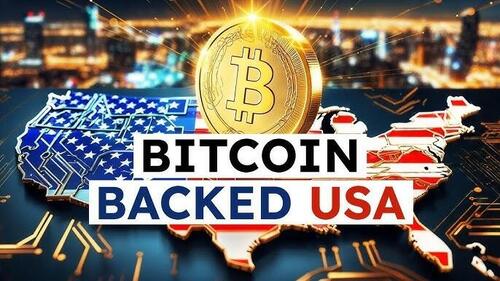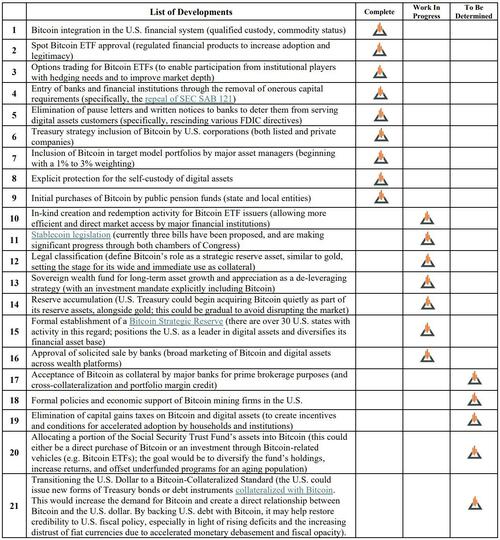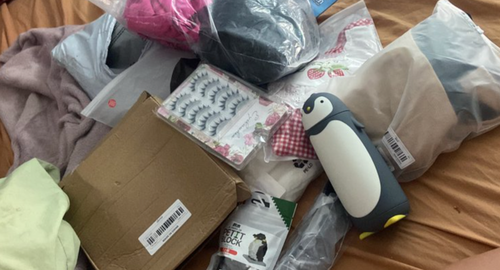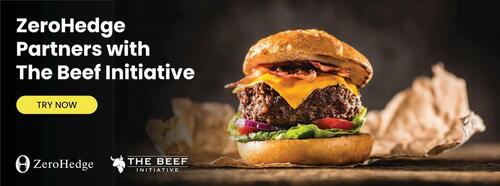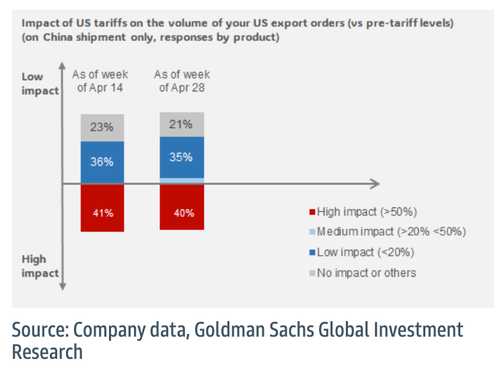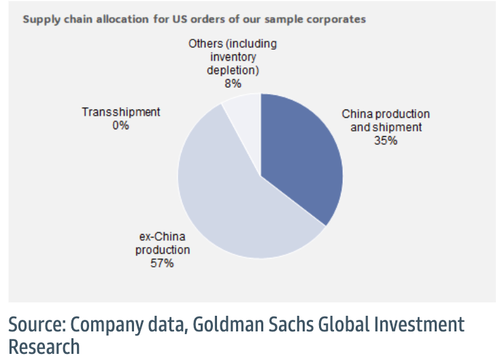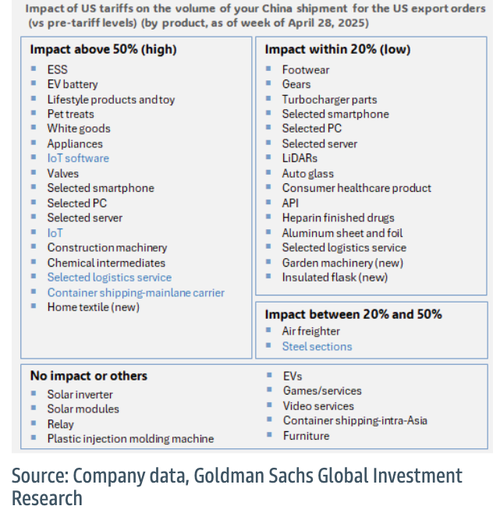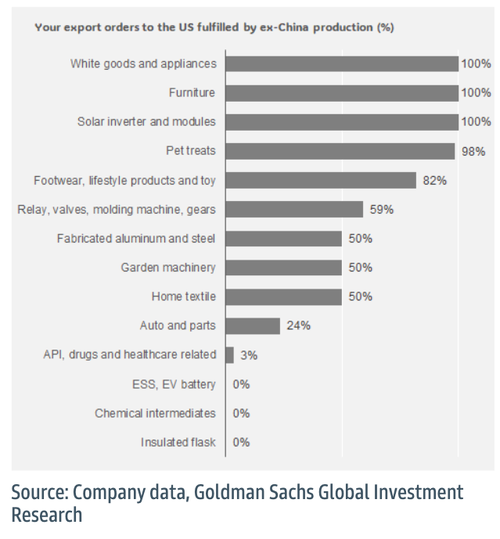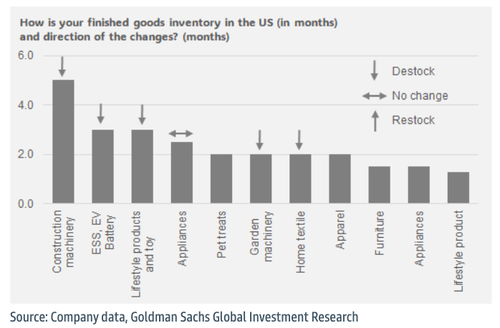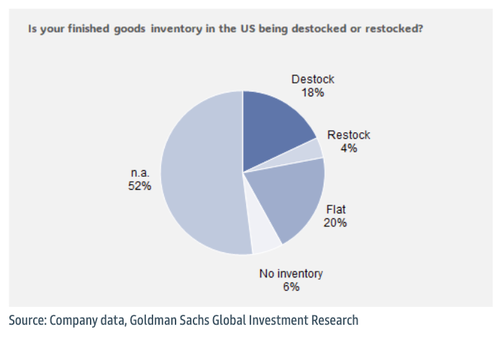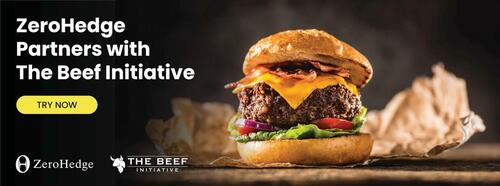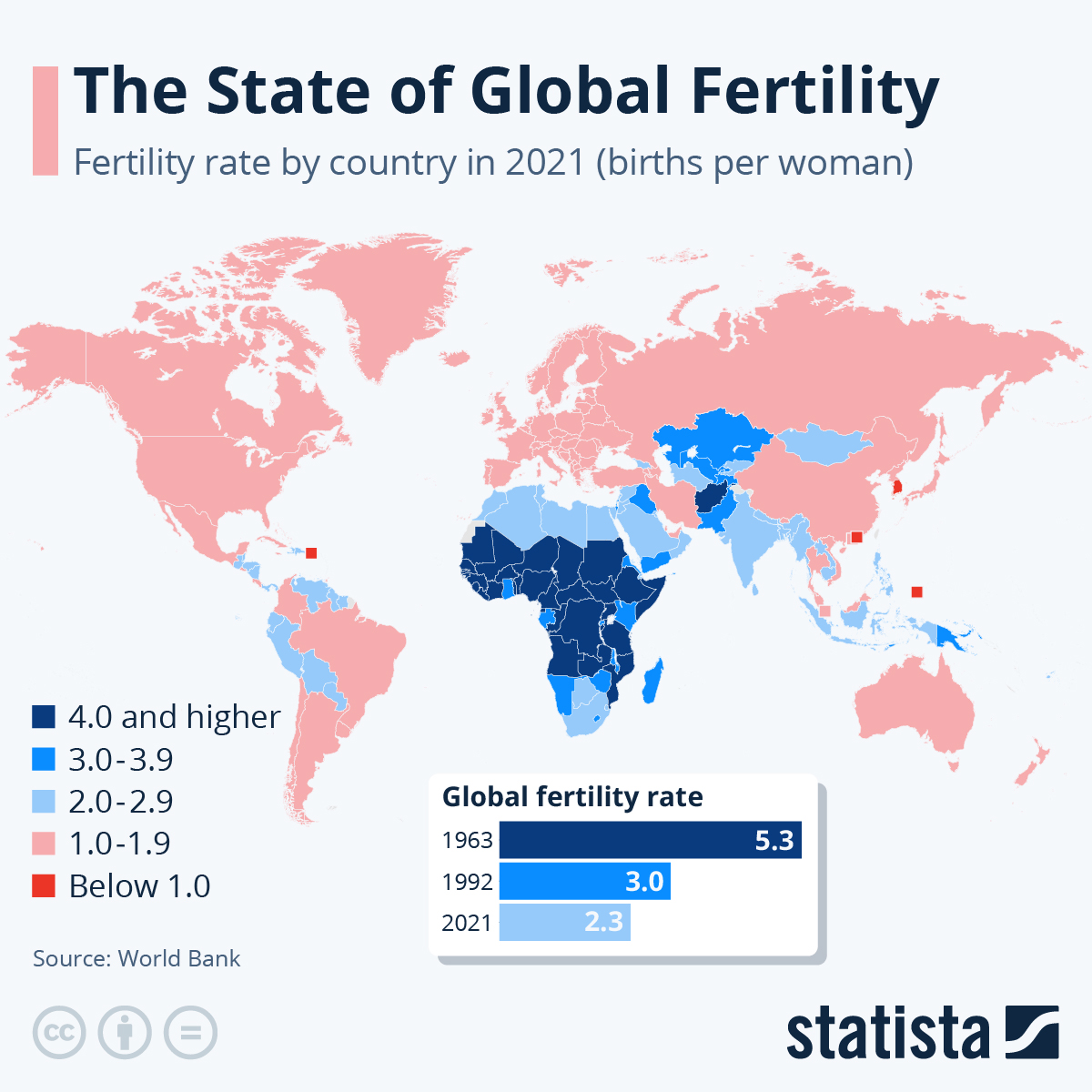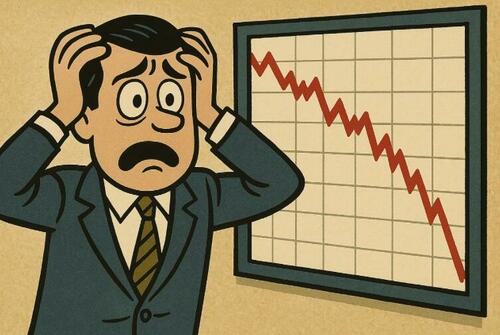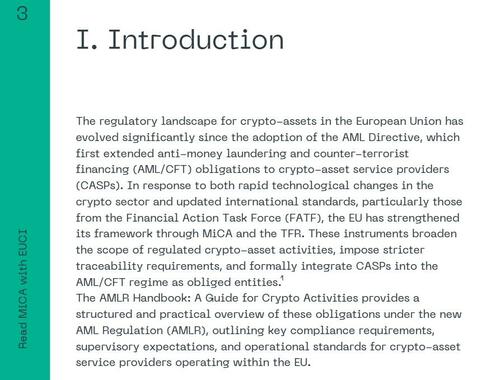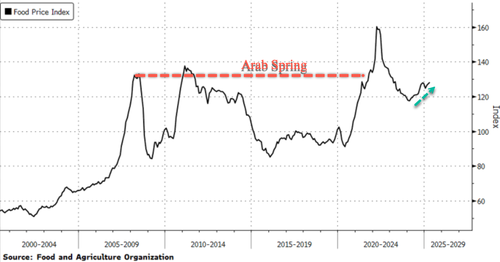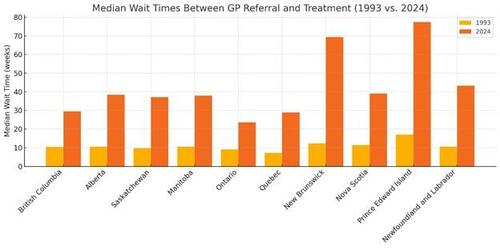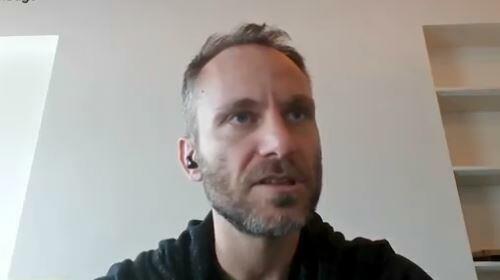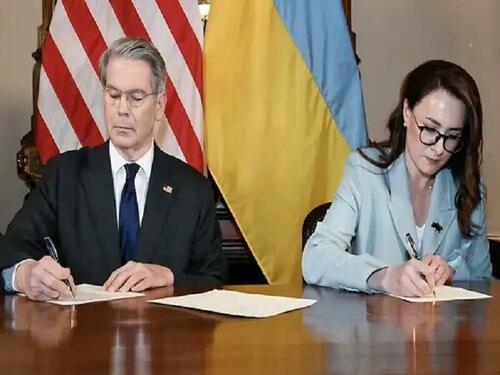Those who with God's help have welcomed Christ's call and freely responded to it are urged on by love of Christ to proclaim the Good News everywhere in the world.
Distinction Matter - Subscribed Feeds
-
Site: Mises InstituteWhen intellectuals and political elites call for equality, they usually mean creating social conditions that are make believe at best and harmful at worst. Their latest hustle is “equity,” which means the state should guarantee equal outcomes for everyone.
-
Site: AsiaNews.itThe Archbishop Emeritus of Bangkok has led the Thai Catholic Church with a focus on mission and inter-religious dialogue. He had promoted the foundation of the Thai Missionary Society - supported by PIME missionary Fr. Adriano Pelosin - closeness to the poor and openness to the Buddhist majority. He will be among the cardinal electors at the next Conclave.
-
Site: Zero HedgeA New Era: The ₿itcoin-Backed Monetary SystemTyler Durden Sat, 05/03/2025 - 12:50
Executive Summary
Since the collapse of Bretton Woods in 1971, the U.S. Dollar has functioned as a fiat currency. The petrodollar agreement in 1974 tied the Dollar indirectly to oil, reinforcing global demand for the Dollar. Today, with increasing skepticism toward fiat currencies and a rising interest in decentralized assets like Bitcoin, the U.S. could consider a new monetary system backed by Bitcoin as a digital, scarce, and decentralized asset. Bitcoin effectively delivers a more modern, automated and software-based approach to central banking.
This piece explores the viability of a Bitcoin-backed monetary system in the context of key historical financial developments, as well as the strategic path for its implementation.
The report concludes with an actionable strategy relevant to policymakers, financial institutions and investors.
-
July 1944 – The Bretton Woods Agreement: The Bretton Woods Conference established the U.S. Dollar as the world’s primary reserve currency, backed by gold. Under this system, the U.S. Dollar was pegged to gold at a fixed rate of $35 per ounce, while other major currencies were pegged to the U.S. Dollar. This agreement created a stable global monetary framework anchored by the U.S. Dollar’s convertibility into gold, and it laid the foundation for post-World War II economic growth.
-
August 1971 – Nixon Closes the Gold Window (“Nixon Shock”): President Nixon suspended the Dollar’s convertibility into gold. This marked the transition of the U.S. dollar from a gold-backed currency to a fiat currency whose value was determined by government decree rather than any fixed and independent asset.
-
October 1973 – The Oil Crisis and Price Shock: In response to U.S. and Western support for Israel, OPEC (led by Saudi Arabia) imposed an oil embargo on the U.S. and several Western nations. The embargo led to a severe shortage of oil, causing prices to quadruple from around $3 per barrel to $12 per barrel by early 1974. This sudden spike in energy costs triggered widespread inflation, economic disruption, and a global crisis that drove stagflation (simultaneously high inflation and high unemployment) in the Western economies.
-
June 1974 – The U.S.-Saudi Petrodollar Agreement: The U.S. and Saudi Arabia reached a pivotal agreement that laid the foundation for the petrodollar system, which later expanded to include other OPEC nations. The establishment of the petrodollar solidified the U.S. Dollar’s status as the world’s primary reserve currency, as the global demand for Dollars increased in conjunction with oil transactions. This arrangement also supported the growth of oil production worldwide and reduced OPEC’s strategic leverage, while providing the U.S. with a reliable source of foreign investment and demand for US government debt.
-
October 2008 – Release of the Bitcoin Whitepaper: In the wake of the global financial crisis and major bank failures, an anonymous inventor known as Satoshi Nakamoto published Bitcoin: A Peer-to-Peer Electronic Cash System. The paper described a transaction network requiring no third-party financial institutions or government intermediaries whatsoever.
-
March 2009 – The Federal Reserve Launches Quantitative Easing (QE): In response to the 2008 financial crisis, the Federal Reserve implemented its first round of Quantitative Easing (QE), purchasing U.S. Treasury bonds and mortgage-backed securities to inject liquidity into the financial system. This unprecedented monetary policy expanded the Fed’s balance sheet and marked the beginning of a prolonged period of U.S. Dollar debasement, fueling sustained asset price inflation.
-
December 2012 – The U.S. Debt-to-GDP Ratio Surpasses 100%: For the first time since World War II, the U.S. debt-to-GDP ratio exceeded 100%, signaling a shift to a highly leveraged fiscal position. This milestone underscored the growing reliance on debt-financed government spending and raised concerns about long-term fiscal sustainability.
-
April 2020 – The Fed Launches Aggressive Quantitative Easing Amid COVID-19 Pandemic: To counter the economic fallout from the COVID-19 pandemic, the Federal Reserve initiated a new round of aggressive QE, again expanding its balance sheet by purchasing Treasury bonds and mortgage-backed securities at an even greater scale. This increase in the money supply significantly debased the U.S. Dollar and drove a surge in asset prices, further exacerbating wealth inequality.
-
February 2022 – The U.S. Freezes Russia’s Foreign Currency Reserves and Weaponizes the U.S. Dollar: In response to Russia’s invasion of Ukraine, the U.S. and its allies imposed severe financial sanctions, freezing Russia’s foreign currency reserves held across Western banks. This action marked a turning point in global financial diplomacy, as it weaponized the U.S. Dollar and raised concerns among other nations about the risks of holding dollar-denominated reserves.
-
March 2022 – Shift Away from the U.S. Dollar in Global Oil Trade: Amid escalating geopolitical tensions, several oilproducing nations began entering bilateral agreements with their trading partners to settle oil transactions in currencies other than the U.S. Dollar. This signaled a potential erosion of the petrodollar system, as countries sought alternatives to reduce reliance on the U.S. Dollar in global trade.
-
June 2023 – Suspension of the U.S. Debt Ceiling: Congress eliminated the debt ceiling, removing the statutory limit on federal government borrowing. This decision effectively allowed unlimited borrowing, raising concerns about unchecked fiscal policy and the potential acceleration of U.S. debt growth, putting further pressure on the Dollar’s stability.
-
January 2024 – Bitcoin ETF Approved: The SEC approved the first spot Bitcoin ETF, paving the way for broader retail and institutional investment. This milestone legitimized Bitcoin, and the ETF wrapper provided easier access for investors, driving increased demand and significant capital inflows.
-
July 2024 – Trump Privately Refers to Bitcoin as “The New Oil”: In a private conversation leaked to the media (but not covered by the mainstream media), former President Donald Trump described Bitcoin as “the New Oil,” signaling a potential shift in U.S. policy toward digital assets. The statement suggests a recognition of Bitcoin’s growing role as a strategic asset in the global financial system.
-
November 5, 2024 – Donald Trump Wins U.S. Presidential Election: In a decisive and landslide electoral victory, Donald Trump is re-elected as President of the United States, with Republicans taking control of both the House and Senate. The election outcome marks a turning point for U.S. policy on digital assets and an end to unfettered regulatory hostility. The Trump administration commits to regulatory clarity, favorable tax policies, the establishment of a Strategic Bitcoin Reserve, and a framework that supports widespread digital asset adoption by individuals, institutions, corporations, pensions and governments.
-
November 8, 2024 – First Middle Eastern Crude Oil Transaction Using Tether Trade Finance: The world’s largest stablecoin firm, Tether, used its trade finance platform to complete its first funding of a crude oil transaction in the Middle East, settling in USDT. This groundbreaking deal appears to herald a major shift in global trade finance, showcasing the adoption of stablecoins as an alternative settlement mechanism for major commodity transactions outside of the traditional banking system.
The Future, and the Case for a Bitcoin-Backed U.S. Monetary System:
Under the petrodollar system, the U.S. effectively allowed the price of oil to rise (in Dollar terms), which increased global oil production and mitigated the strategic threat posed by OPEC. By creating a large, Dollar-denominated asset class (oil), the U.S. also established a mechanism to support the Dollar’s dominance abroad and finance its growing deficits at home. Surplus oil revenues from OPEC nations were recycled into U.S. Treasuries, reinforcing demand for the Dollar and giving the U.S. tremendous economic power globally.
Domestically, this system enabled politicians to engage in extensive borrowing and spending, driving U.S. debt from 36% of GDP in 1971 to ~125% today, a trajectory that now poses a serious challenge to the U.S. as a financial superpower, as well as its energy and national security.
Even at a ~$2 trillion market value, and with over ~$20 billion in average daily trading volume, Bitcoin is not yet large enough to replace the petrodollar as the backbone of the U.S. monetary system. However, a significant increase in Bitcoin’s price could catalyze a new paradigm.
Higher Bitcoin prices would likely drive substantial growth in U.S. Dollar-backed stablecoin issuance (due to the greater total market value of the asset class, and as the network effects of Bitcoin and digital asset transactions take hold);.
In turn, stablecoin issuance would directly boost demand for U.S. Treasury bills, effectively shifting the backstop of U.S. deficits from oil to Bitcoin.
This would allow the U.S. to maintain its monetary dominance while undermining the strategic power of the BRICS nations, who have turned to gold in an attempt to challenge and circumvent the Dollar system.
There are several recent developments that indicate the groundwork for this transition may already be underway.
The framework that follows is a preliminary outline of the potential steps towards a Bitcoin-Backed Monetary System.
The 21-Step Integration of Bitcoin into the U.S. Financial System:
Calculating the Required U.S. Ownership of Bitcoin:
When considering the transition to a Bitcoin-backed monetary system, M2 money supply provides the most comprehensive measure of U.S. Dollar liquidity in the economy. M2 includes not only cash and checking deposits (collectively defined as M1), but also savings accounts, money market funds, and other near-money assets.
This broader measure captures the full extent of Dollar-denominated assets that circulate and store value within the U.S. economy.
Key Assumptions:
-
Current U.S. M2 Money Supply: $22 trillion
-
Projected U.S. M2 Money Supply in 2045: $79 trillion (applying the 6.7% CAGR from 2000-2024)
-
Projected Bitcoin Price Target in 2045: $13 million (per Michael Saylor’s Bitcoin24 Model)
-
Capital Investment Today: Funded through partial monetization of official existing U.S. gold holdings (8,133 tonnes with a current market value of $764 billion); for simplification, assumes constant price of gold
-
Fully Diluted Bitcoin Supply: 21 million Bitcoin
-
Adjustment for Theoretical versus Actual Supply: It is estimated that 3 to 4 million Bitcoin may be lost or irretrievable, making the effective supply closer to 17 to 18 million Bitcoin. However, for simplicity and to maintain a conservative estimate, the maximum supply of 21 million Bitcoin is used
-
Below is a table showing the required U.S. ownership of Bitcoin for different levels of backing by 2045:
Bitcoin Backing Scenario Analysis
Note: Analysis is for illustrative purposes only; market data is as of 2/26/2025 and from publicly available sources.
Scenario Overviews:
1) 25% Backing
- This level of backing by the U.S. could serve as a hedge or partial reserve, similar to the role gold used to play in the early 20th century.
2) 50% Backing
- A 50% backing level implies a much more substantial reliance on Bitcoin within the U.S. monetary system. Increasing Bitcoin’s allocation not only accelerates its global adoption and reinforces its credibility as a reserve asset, but it also provides a meaningful hedge against escalating U.S. debt. With projections suggesting that the national debt could balloon to approximately $115 trillion by 2045 (based on extrapolation), a 50% backing could potentially offset up to 34% of that burden.
3) 100% Backing
-
Full backing would represent a Bitcoin standard, where the entire U.S. M2 money supply is backed by Bitcoin.
-
A full Bitcoin backing serves as a complete hedge against fiat debasement and central bank policy errors, positions the U.S Dollar as a purely hard-money asset, and reduces Net Debt to GDP to under 100% by reducing nearly 70% of the nation’s debt burden.
A Bitcoin-backed system would leverage Bitcoin’s superior characteristics as a harder and scarcer asset than gold, positioning the U.S. as a first mover in adopting a supranational, independent and digital reserve asset. The concept of transitioning to a new U.S. monetary system backed by Bitcoin as collateral is both ambitious and transformative. It represents a profound shift from the current fiat-based, debt-financed model towards a digital, decentralized, and scarce foundational asset.
-
-
Site: Zero HedgeTemu Ends China Shipments To US After Trump Closes "De Minimis" LoopholeTyler Durden Sat, 05/03/2025 - 12:15
Container volumes at one of America's busiest ports are falling fast. President Trump's 145% tariffs on Chinese goods entering the U.S. are wreaking havoc on trans-Pacific containerized trade, triggering a sharp decline in shipments from Chinese ports.
On Friday, Chinese e-commerce giant Temu halted U.S. deliveries after the Trump administration closed the "de minimis" loophole, which had previously allowed a flood of Chinese junk under $800 to enter tariff-free.
The move signals a further decline in Chinese imports to the U.S.
Ahead of Friday's end of the de minimis exemption for China-made goods, Temu hiked prices and rolled out a complete breakdown of customer import charges. Singapore-based e-commerce website Shein Group also hiked prices.
Temu confirmed late Friday to the New York Times: "This shift is part of Temu's ongoing adjustments to improve service levels."
The use of de minimis by Chinese e-commerce has surged in recent years, with Temu and Shein connecting U.S. consumers with cheap Chinese goods priced 20% to 30% less than U.S. competitors like Amazon.
According to the U.S. Customs and Border Protection, nearly 1.4 billion shipments entered the U.S. in 2024 through the de minimis loophole, up from 637 million four years earlier.
The nuking of the de minimis loophole comes from President Trump, who has previously called the exemption "a big scam" that hurts small American businesses.
Kim Glas, the president of the National Council of Textile Organizations, said the exemption allowed "unsafe and illegal Chinese goods" to flood the U.S. duty-free for years.
"Today's action by the administration is an important step forward to help rebalance the playing field for American manufacturers," Glas told the NY Times.
Separately, the second edition of Goldman analyst Trina Chen's China Export Tracker—covering 48 companies representing 70% of China's export value to the U.S. by product group—offers new insight into trade flows and growing uncertainty across key trans-Pacific shipping lanes linking Chinese ports to the U.S. West Coast.
Here are some of Chen's findings:
Nearly 40% of products are seeing substantial impact on their China shipments for U.S. orders, as of week of April 28
U.S. orders were fulfilled- 35% from China shipments, and 57% from ex-China production, as of week of April 28
Impact of U.S. tariffs on the volume of U.S. export orders by product (for China shipment) - as of week of April 28
Ex-China production provides significant supply chain flexibility for many consumer related products
Finished goods inventory in the U.S. quoted by producers and shippers ranged from 1.5 months to 5 months
U.S. monthly container imports are still in positive growth as of March-25, but total imports are projected to fall by nearly 30% in the coming months
Comments from exporters:
-
Orderbook has been received to 3Q25, but uncertainty remains for 4Q25 orders.
-
Orderbooks from the U.S. have not changed, nor have there been rush orders. Visibility of 2025 annual orderbook can be seen to extend to July-August. But later Beyond that, much will depend on tariffs on Vietnam - an escalated level will affect consumer spending and impact 4Q25, thus flexibility of producers should be kept.
-
Shipments from SEA recovered on the back of the 90-day suspension of the reciprocal tariff. Communication with customers was only viable after stabilization. In early April, the shipment of orders to the U.S. mostly stopped, and now new orders have gradually come in. But shipment remains short of full year expectations.
-
Orderbooks for the factories in North America are strong, extending the typical forward visibility from 2-3 months, to 3-4 months. There are still some uncertainties in the export from Cambodia to the U.S., but production and shipment remains normal.
-
There have been no significant changes in orders and demand, and shipments are still being made continuously, all according to customer requirements for timely delivery.
-
There have been no changes observed in orders.
-
The company has not seen advanced or accelerated purchases by U.S. consumers in anticipation of tariff induced price hikes.
-
Considering the uncertainty of tariffs, U.S. customers slightly increased their orders during the 90-day exemption period.
-
U.S. orders are suspended. Other regions have broken large-sized orders into small and higher-frequency orders.
-
Export to Europe might be higher this year. Export to Southeast Asia and South America is on track and there are no major changes.
-
There are no order cuts, although some customers asked to delay or advance in shipment. Production remained at a normal in pace, given that they are all standard products and we can always find buyers can readily be found even if another someone cancels.
-
Normal production and shipment. The customer did not adjust the purchase plan.
-
The current orders from the U.S. have increased by 10% on average, compared to before the reciprocal tariff was announced. The shipments of lawn mowers and clothing can be sent domestically and overseas.
-
Shipments from China to the U.S. have stopped, versus a 30% drop in mid-April.
-
Shipments from China to the U.S. have been are cut off, and have was mostly stopped ~(20%) as of mid of April.
-
Softening demand induced by IRA uncertainty is the key challenge in the U.S. U.S. orders further slowed down in the past two weeks, especially in utility scale projects. Moreover, given final anti-dumping (AD)/countervailing duty (CVD) determination for the four ASEAN countries came in higher than the preliminary version, potentially higher product price in the U.S. could further dampen downstream demand.
-
Solid demand in the U.S. market, with new orders in thousands of units seen from customers. However, Chinese production for the U.S. orders has stopped, and has been fully replaced by products from other regions, with high utilization rate. Orderbook is solid into July, and 2Q shipment to Korea, UK, Australia, India, Brazil and Middle East was solid.
-
Tariffs have had limited impact on the company YTD. Exports to North America have declined slightly, but more driven by the nature of the demand rather than tariffs. And most of the U.S. orders were produced in facilities in Mexico. Alternate supplies are challenging to procure, most of these products are difficult to replace in the short term, and if any, it will still be among Chinese producers.
-
The direct orders for commercial HVAC components from China to the U.S. have been completely suspended, as customers are considering supply chain changes. Production of commercial HVAC in China has not been suspended — although there are no new orders from the U.S., the production can still supply other regions. Residential HVAC components are currently supplied to the U.S. from Vietnam, and there has been no change so far, as per our onshore tariff impact report.
-
Orders for machinery had delays in the first week of April, given the uncertainty. But recovery from the emerging markets started in the second week and continued in the 3rd week.
-
There has been no change in U.S. orders; the currently imposed tariff is not 145%, but lower, because the reciprocal tariffs only apply to a specific list of goods.
-
For the U.S. market, the company is basically either the sole supplier or a critical supplier, making short-term replacement difficult.
-
Producers mainly cooperate with small brands, which can export and change a label and then re-export to the U.S.
-
Producers now take orders from the U.S. as normal, versus suspending the order two weeks ago. The impact on shipments was about 20-50% but gradually recovering. Currently in normal production.
-
Transpacific routes: In mid-April, a sequential decline of 12-13% in container volumes on Transpacific routes (vs. Mar-2025) was observed, and it deepened to 20% in late week of April 21, and may further deepen to 25-30% in May. The container volume from SEA to U.S. is stable. Company believes the decline in transpacific routes is mainly due to the sharp drop in cargo volume departing from China, while cargo volume departing from Southeast Asia is relatively stable. There is some speculation that there is re-export trade involved but it cannot be separated.
-
The company observed container volume increased on China-to-Southeast Asia routes in April vs. March and sees further upside to cargo volumes within the 90-day window of reciprocal tariff delay. Among Southeast Asia routes, Thailand and Vietnam have seen more significant volume growth. Solar-related products have seen larger volume declines, while household goods remain stable.
-
It is expected that De minimis (accounts for 30-40% of U.S. routes cargo) could decline by 45-50% in May after the removal of De minimis on Chinese products takes effect from May 2nd.
. . .
-
-
Site: Rorate CaeliThe pope has died. As good Catholics we always pray for and commend the souls of all who have died to the mercy of God. This we also do for the man chosen by conclave in 2013 to serve in the office of supreme pontiff for these past twelve years. Requiescat in pace, Pope Francis. One of the most important consolations for all of us, if not the ultimate gift, are the prayers of the Church, Father Kevin M Cusick http://www.blogger.com/profile/04460394747724581336noreply@blogger.com
-
Site: Zero HedgeWe Don't Need An Executive Order To Bar Illegals From Social Security - We Need A Government That Obeys The LawTyler Durden Sat, 05/03/2025 - 11:40
Authored by Maureen Steele via American Greatness,
In what universe does it make sense that the President of the United States has to sign an executive order to stop illegal aliens from receiving Social Security benefits? That’s not just an absurd headline—it’s a tragic indictment of how far this nation has strayed from the rule of law, common sense, and constitutional integrity.
Let’s get one thing straight: illegal immigrants are already barred from receiving Social Security benefits. Full stop. It’s enshrined in federal law, constitutional precedent, and the very fabric of what it means to be a sovereign nation. Yet here we are, once again watching a president step in with a pen to “reaffirm” what is already carved into stone.
Under Section 1611 of the Social Security Act (42 U.S.C. § 1382c), individuals who are not lawfully present in the United States are categorically ineligible for Supplemental Security Income (SSI). The Personal Responsibility and Work Opportunity Reconciliation Act of 1996 (PRWORA) explicitly excludes most non-citizens from federal means-tested public benefits. And let’s not forget 8 U.S.C. § 1611, which states unequivocally, “Notwithstanding any other provision of law…an alien who is not a qualified alien…is not eligible for any Federal public benefit.”
Translation: They’re already prohibited.
So why does Trump need to sign an executive order?
Because we are no longer a nation governed by laws—we are a nation governed by selective enforcement, political cowardice, and bureaucratic betrayal.
While illegals exploit the system through loopholes crafted by activist judges and globalist legislators, hardworking Americans who’ve paid into Social Security their entire lives are being told the well is running dry. They’re mocked with headlines about “entitlement reform” and threatened with benefit cuts, while watching their tax dollars fund services for people who have no legal right to be here.
Let me say this plainly: illegal aliens should not be here. That’s the real issue—not whether they’re tapping into Social Security.
The fact that we have to publicly debate whether to let foreign nationals steal from a system built by and for American workers is the very definition of national rot.
And let’s talk about Social Security itself.
The system is broken—not because of American retirees, but because of government theft, mismanagement, and legislative sleight of hand.
Congress has raided the trust fund, spent it on everything from foreign wars to gender studies in Pakistan, and now pretends it’s our fault there’s a shortfall. The average American would be better off putting that 6.2% payroll tax into a private investment fund and watching it grow rather than letting corrupt bureaucrats bleed it out into the black hole of government waste.
You know what would truly protect Social Security? Not just an executive order. Mass deportations. A sealed border. A total shutdown of the welfare pipeline that flows to non-citizens, non-contributors, and non-patriots.
That would protect American seniors. That would honor the American worker.
And to those who think we need “more laws” to fix this—stop it. We don’t need more laws. We need courage. We need leaders who enforce the laws already on the books. Article IV, Section 4 of the Constitution guarantees every state in this union a republican form of government and protection against invasion. What do you call millions of illegal crossings per year if not an invasion?
This is not about compassion.
It’s about justice, sovereignty, and survival.
A nation that can’t tell the difference between a citizen and a foreign intruder isn’t a nation—it’s a playground for parasites.
President Trump’s order may make a splash. It may draw cheers. But let’s not lose sight of the bigger truth: the law is already clear. The Constitution already speaks. The betrayal is not in what’s being signed but in what’s being ignored.
We don’t need more executive orders. We need a government that does its damn job.
-
Site: Henrymakow.com
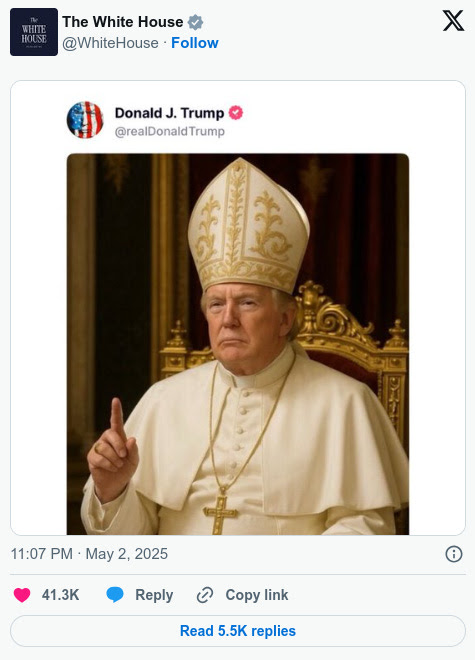 Left, Tweeted by the White HousePlease send links and comments to hmakow@gmail.comWhy would Trump settle for Pope when the position of God remains vacant?Australia Repeats Canada's Anti Trump Tariff Move to the LEFTAustralia's Albanese claim election victory, riding anti-Trump wavei------Carney reveals King Charles III will deliver Speech from the ThroneHe called the king's acceptance of his request "an historic honour."Not a good look for a foreign national to be giving this speech, but typical of Globalists who wish to destroy national identity.----Reader--Isaiah 17's DESTRUCTION of Damascus & Iran's Prophetic DOWNFALL | Rosenberg ReportChristian Zionist Nohaide cult members......being taught the Talmud and the Zohar, as always.Isaiah 17 is a prophecy of 70AD. The Zohar states that a definite sign of Moschiach's imminent arrival is the fall of President Assad (his name is encoded in it).Rosenberg talks about wicked Gog coming to invade the Holy Land soon....GOG INVADED THE HOLY LAND IN 1948----MICHAEL O'BOMBER FINALLY ADMITS HE IS A MAN:From Parick O'Carroll--"Now we only need admissions from "Male Linda" Gates, from the "husband" of Germany's ex-chancellor Olaf Scholz, from the "husband" of Emmanuel Macron, and also from Kissinger's "husband" who calls himself "Nancy Sharon Maginnes" and bears a slight resemblance to Roger Waters of Pink Floyd: https://ibb.co/3Y5TpT7W.Emmanuel Macron's "husband" goes by "Brigitte Macron" but is really Jean-Michel de Rothschild, or the current "Mafia Don" of the French House of Rothschild. The current "Mafia Don" of the British House of Rothschild is Nathaniel Rothschild, who appears to be working with Trump and may even be Trump's Top Zionist Handler.--
Left, Tweeted by the White HousePlease send links and comments to hmakow@gmail.comWhy would Trump settle for Pope when the position of God remains vacant?Australia Repeats Canada's Anti Trump Tariff Move to the LEFTAustralia's Albanese claim election victory, riding anti-Trump wavei------Carney reveals King Charles III will deliver Speech from the ThroneHe called the king's acceptance of his request "an historic honour."Not a good look for a foreign national to be giving this speech, but typical of Globalists who wish to destroy national identity.----Reader--Isaiah 17's DESTRUCTION of Damascus & Iran's Prophetic DOWNFALL | Rosenberg ReportChristian Zionist Nohaide cult members......being taught the Talmud and the Zohar, as always.Isaiah 17 is a prophecy of 70AD. The Zohar states that a definite sign of Moschiach's imminent arrival is the fall of President Assad (his name is encoded in it).Rosenberg talks about wicked Gog coming to invade the Holy Land soon....GOG INVADED THE HOLY LAND IN 1948----MICHAEL O'BOMBER FINALLY ADMITS HE IS A MAN:From Parick O'Carroll--"Now we only need admissions from "Male Linda" Gates, from the "husband" of Germany's ex-chancellor Olaf Scholz, from the "husband" of Emmanuel Macron, and also from Kissinger's "husband" who calls himself "Nancy Sharon Maginnes" and bears a slight resemblance to Roger Waters of Pink Floyd: https://ibb.co/3Y5TpT7W.Emmanuel Macron's "husband" goes by "Brigitte Macron" but is really Jean-Michel de Rothschild, or the current "Mafia Don" of the French House of Rothschild. The current "Mafia Don" of the British House of Rothschild is Nathaniel Rothschild, who appears to be working with Trump and may even be Trump's Top Zionist Handler.--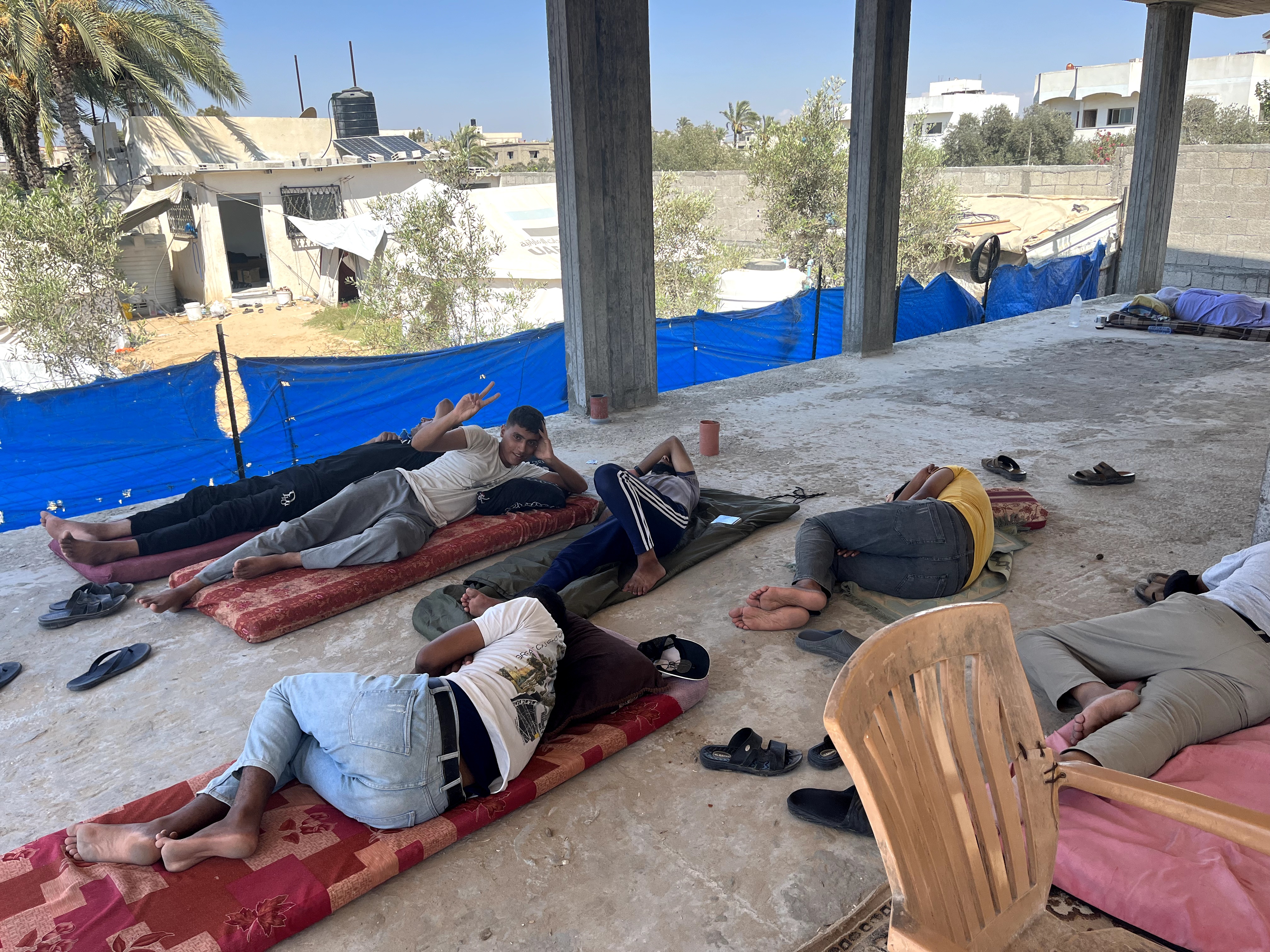 "This is our daily life in tents. Adults and children alike escape the scorching sun and take to the streets and roads to find a place to shelter and protect us from the bombardment. In your opinion, who can live like this? Can anyone in the world endure this? No one feels for us here. Spread the word and get our message out to the world."A Way to Help Gaza---Brandon Smith--War Between The US And Canada? Yes, It's Now A Real PossibilityThere is something explosive going on under the surface of US/Canada relations and it could very well end with a US invasion to the north.---
"This is our daily life in tents. Adults and children alike escape the scorching sun and take to the streets and roads to find a place to shelter and protect us from the bombardment. In your opinion, who can live like this? Can anyone in the world endure this? No one feels for us here. Spread the word and get our message out to the world."A Way to Help Gaza---Brandon Smith--War Between The US And Canada? Yes, It's Now A Real PossibilityThere is something explosive going on under the surface of US/Canada relations and it could very well end with a US invasion to the north.---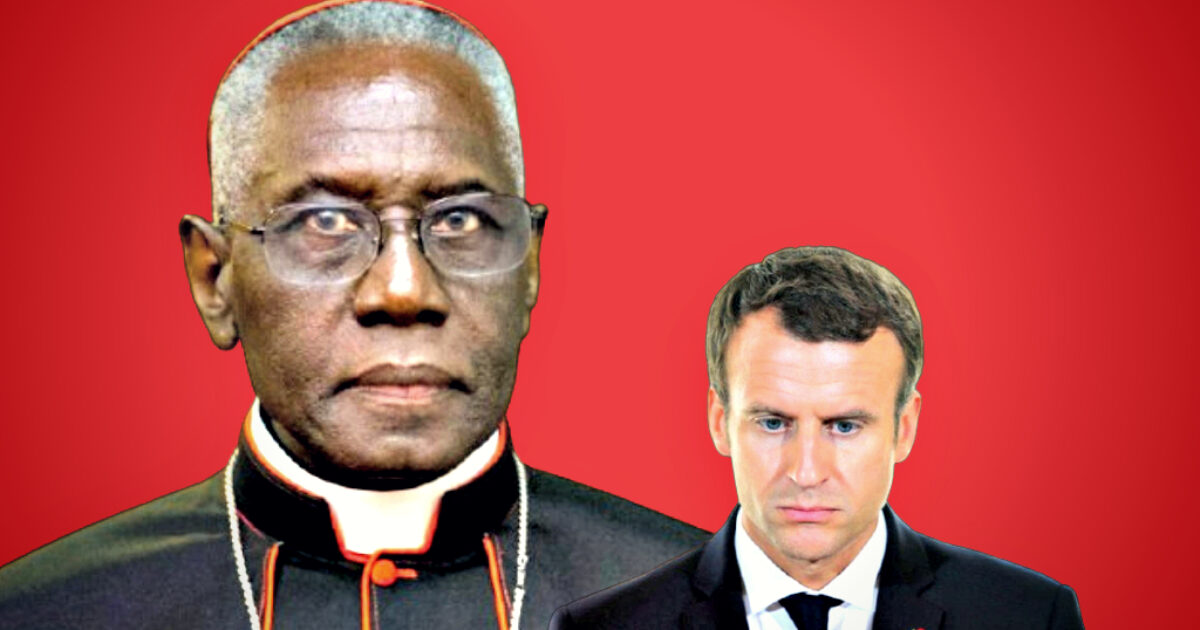 France's Macron Reportedly Meddling in the Choosing of the Next Pope - Is Terrified That Conservative Robert Sarah May Sit On St. Peter's Throne"Since the death of Francis on April 21, newspapers close to Giorgia Meloni's government have been speculating on the designs of Emmanuel Macron, accused of implementing a strategy aimed at pushing his candidates to the throne of St. Peter."--Iran says US 'not serious' about nuclear talks after Trump imposes new sanctionsTehran says it is committed to reaching a 'fair agreement' despite US President Trump's announcement of secondary sanctions on firms and countries purchasing Iranian oil-Auto Loan Delinquency Rate is at its highest level in 14 years-Digitization Of The U.S. Federal Monetary System Begins With The Phase Out Of Paper Check Disbursements And Receipts"The Order mandates that, effective September 30, 2025, the Federal government will cease issuing paper checks for all disbursements, including intragovernmental payments, benefits, vendor payments, and tax refunds."---Japan hints at using U.S. Treasury holdings as leverage in high-stakes trade talks with Trump-Farage's party making big gains in local British elections"The right-wing Reform UK party has won 677 out of more than 1,600 seats in England's local elections, while the Labour and the Conservative parties suffered heavy defeats across the country."Only Communists would regard freedom and independence as "right wing."It's only far right to the FAR LEFT.
France's Macron Reportedly Meddling in the Choosing of the Next Pope - Is Terrified That Conservative Robert Sarah May Sit On St. Peter's Throne"Since the death of Francis on April 21, newspapers close to Giorgia Meloni's government have been speculating on the designs of Emmanuel Macron, accused of implementing a strategy aimed at pushing his candidates to the throne of St. Peter."--Iran says US 'not serious' about nuclear talks after Trump imposes new sanctionsTehran says it is committed to reaching a 'fair agreement' despite US President Trump's announcement of secondary sanctions on firms and countries purchasing Iranian oil-Auto Loan Delinquency Rate is at its highest level in 14 years-Digitization Of The U.S. Federal Monetary System Begins With The Phase Out Of Paper Check Disbursements And Receipts"The Order mandates that, effective September 30, 2025, the Federal government will cease issuing paper checks for all disbursements, including intragovernmental payments, benefits, vendor payments, and tax refunds."---Japan hints at using U.S. Treasury holdings as leverage in high-stakes trade talks with Trump-Farage's party making big gains in local British elections"The right-wing Reform UK party has won 677 out of more than 1,600 seats in England's local elections, while the Labour and the Conservative parties suffered heavy defeats across the country."Only Communists would regard freedom and independence as "right wing."It's only far right to the FAR LEFT. -
Site: RT - News
Moscow has called the move “blasphemous” and “disrespectful” due to Kiev’s open glorification of Nazism
Ukrainian troops will take part in the World War II Victory Day parade in London on May 8 at the invitation of the UK government, the British Ministry of Defense has announced. Moscow has condemned the move as “blasphemous” and “disrespectful” due to Kiev’s open glorification of Nazism.
Victory in Europe Day (VE Day) is celebrated in the West on May 8 to commemorate Nazi Germany’s surrender in 1945.
In a post on X on Saturday, the UK MOD said Ukrainian troops will take part in a military procession commemorating the event alongside 1,000 British servicemen. The ministry claimed that Kiev’s participation in the event “reminds us that Ukraine is now at freedom’s front line.” UK Defense Secretary John Healey described it as “fitting” that Ukrainian troops will be present at the event.
Moscow has condemned London’s decision. “Inviting followers of neo-Nazi elements to Victory Day celebrations is not just disrespectful to those British veterans who gave their lives during World War II. It is blasphemy,” Kremlin spokesman Dmitry Peskov said on Saturday.
Read more Ukrainian youths perform Nazi salute at Holocaust memorial (PHOTOS)
Ukrainian youths perform Nazi salute at Holocaust memorial (PHOTOS)
Commemorations of WWII-era nationalist figures linked to Nazi Germany have been common in Ukraine. Ukrainian nationalists hold annual torchlight marches in Kiev, Lviv, and other cities in honor of Stepan Bandera, the leader of the Organization of Ukrainian Nationalists (OUN), which collaborated with the Nazis and took part in the massacre of more than 100,000 Poles, Jews, Russians, and Soviet-aligned Ukrainians.
Throughout the conflict with Russia, Ukrainian troops have on numerous occasions been filmed displaying Nazi symbols, including patches of SS units and swastikas. Italy’s Rai News 24 apologized last year after a journalist interviewed a Ukrainian fighter wearing a cap with the emblem of the ‘Leibstandarte Adolf Hitler’ SS division.
Germany previously expelled seven Ukrainian soldiers undergoing military training in the country because they were wearing Nazi symbols.
READ MORE: German state media shows Nazi insignia from Ukrainian boot camp for kids
Ukraine’s notorious Azov unit, a neo-Nazi formation established in 2014 and later integrated into the National Guard, has been accused of war crimes and was designated a terrorist organization by Russia in 2022. Although the original Azov Battalion was defeated in the 2022 Battle of Mariupol, co-founder Andrey Biletsky launched the 3rd Separate Assault Brigade under the Azov banner in 2023, which remains active.
Russia has repeatedly warned of a Nazi revival in Ukraine and has accused Kiev of embracing neo-Nazi ideology while whitewashing WWII collaborators. President Vladimir Putin listed “denazification” among the goals of Russia’s military operation against the Kiev regime, along with demilitarization and neutrality.
-
Site: RT - News
Moscow has called the move “blasphemous” and “disrespectful” due to Kiev’s open glorification of Nazism
Ukrainian troops will take part in the World War II Victory Day parade in London on May 8 at the invitation of the UK government, the British Ministry of Defense has announced. Moscow has condemned the move as “blasphemous” and “disrespectful” due to Kiev’s open glorification of Nazism.
Victory in Europe Day (VE Day) is celebrated in the West on May 8 to commemorate Nazi Germany’s surrender in 1945.
In a post on X on Saturday, the UK MOD said Ukrainian troops will take part in a military procession commemorating the event alongside 1,000 British servicemen. The ministry claimed that Kiev’s participation in the event “reminds us that Ukraine is now at freedom’s front line.” UK Defense Secretary John Healey described it as “fitting” that Ukrainian troops will be present at the event.
Moscow has condemned London’s decision. “Inviting followers of neo-Nazi elements to Victory Day celebrations is not just disrespectful to those British veterans who gave their lives during World War II. It is blasphemy,” Kremlin spokesman Dmitry Peskov said on Saturday.
Read more Ukrainian youths perform Nazi salute at Holocaust memorial (PHOTOS)
Ukrainian youths perform Nazi salute at Holocaust memorial (PHOTOS)
Commemorations of WWII-era nationalist figures linked to Nazi Germany have been common in Ukraine. Ukrainian nationalists hold annual torchlight marches in Kiev, Lviv, and other cities in honor of Stepan Bandera, the leader of the Organization of Ukrainian Nationalists (OUN), which collaborated with the Nazis and took part in the massacre of more than 100,000 Poles, Jews, Russians, and Soviet-aligned Ukrainians.
Throughout the conflict with Russia, Ukrainian troops have on numerous occasions been filmed displaying Nazi symbols, including patches of SS units and swastikas. Italy’s Rai News 24 apologized last year after a journalist interviewed a Ukrainian fighter wearing a cap with the emblem of the ‘Leibstandarte Adolf Hitler’ SS division.
Germany previously expelled seven Ukrainian soldiers undergoing military training in the country because they were wearing Nazi symbols.
READ MORE: German state media shows Nazi insignia from Ukrainian boot camp for kids
Ukraine’s notorious Azov unit, a neo-Nazi formation established in 2014 and later integrated into the National Guard, has been accused of war crimes and was designated a terrorist organization by Russia in 2022. Although the original Azov Battalion was defeated in the 2022 Battle of Mariupol, co-founder Andrey Biletsky launched the 3rd Separate Assault Brigade under the Azov banner in 2023, which remains active.
Russia has repeatedly warned of a Nazi revival in Ukraine and has accused Kiev of embracing neo-Nazi ideology while whitewashing WWII collaborators. President Vladimir Putin listed “denazification” among the goals of Russia’s military operation against the Kiev regime, along with demilitarization and neutrality.
-
Site: Zero HedgeThe State Of Global FertilityTyler Durden Sat, 05/03/2025 - 11:05
South Korea, together with Hong Kong, Macau and Puerto Rico, is one of only a few places in the world with a fertility rate below 1, data by the World Bank shows.
In Japan, another Asian country known to struggle with low birth rates, average births per woman remained at 1.2 in 2023. This places the country among the more than 90 in the world where populations are not growing independent of immigration. Also in this group are many nations from Europe, the Americas and Southeast Asia.
Most of the countries losing fertility are better developed and reasons for the trend include greater access to contraception and more women being educated and heading to work.
As Statista's Katharina Buchholz shows in the chart below, the story is different in the developing world where higher rates of fertility are fueling continued global population growth.
You will find more infographics at Statista
Somalia, Chad, Niger and the Democratic Republic of the Congo had a fertility rates of 6.1 in 2023, the highest in the world, followed by the Central African Republic and Mali.
Out of the 31 countries in the world where women had 4 or more children on average, 29 were in Africa that year.
On average, women in 1963 were having 5.3 children in their lifetime and by 2023, that had more than halved to 2.2.
During the same period, the global population rose by around 150 percent from 3.2 billion to 8.1 billion.
The fact that populations kept (and keep) growing despite falling global fertility is tied to longer life expectancy and lower childhood mortality.
The UN expects global fertility to reach the minimum replacement level of 2.1 by the middle of the century while global population is expected to start falling towards the end of it.
-
Site: Ron Paul Institute - Featured Articles
One of the world’s, oldest and most dangerous conflicts went critical this past week as nuclear armed India and Pakistan traded threats of war. The Kashmir conflict is the oldest one before the UN.
In my book `War at the Top of the World’ I warned that the confrontation over Kashmir, the beautiful mountain state claimed by both Islamabad and Delhi, could unleash a nuclear war that could kill millions and pollute the planet.
After three wars and many clashes, it seemed the two bad neighbors had allowed the Kashmir dispute to fade into the background as their relations slightly improved.
Then came the murder last week of 26 Indian tourists at Pahalgam, a Kashmir beauty spot, by Muslim insurgents. Kashmir was roughly divided between India and Pakistan in 1947. The larger part of Kashmir was annexed by Indian troops as the entire region was scourged by massacres and rapine.
As a result, India’s portion of Kashmir became the only Muslim majority state in India. Kashmiri Muslims have waged a bloody struggle since the 1980’s to leave India or join Pakistan. Today, 500,000 Indian troops and an equal number of paramilitary police garrison the restive province.
I’ve been under fire three times on the Line of Control that separates the two Kashmirs and at 15,000 feet altitude on the remote Siachen Glacier. I was with Pakistani President Musharraf after he tried to seize Kargil which lies above Kashmir.
The outside world cared little about the India-Pakistan conflict until both Delhi and Islamabad acquired nuclear weapons. Their ‘hatred of brothers’, as I called it, pits fanatical Hindus against equally ardent Muslims who share centuries of hatred and are being whipped up by politicians.
Right wing Hindu militants in Delhi demand reunification of pre-1947 ‘Mother India.’ Pakistan has about 251 million citizens; India has 1.4 billion and a much larger GDP. Pakistan would be unable to resist a full-bore attack by India’s huge armed forces. So, it relies on tactical nuclear weapons to compensate for the dangerous imbalance.
But both sides nuclear arsenals are on hair-trigger alert and pointed at the subcontinent’s major cities. A decade ago, the US think tank Rand Corp estimated an India-Pakistan nuclear exchange would kill three million immediately and injure 100 million. Such damage would pollute most of the region’s major riverine water sources all the way down to Southeast Asia.
Given the region’s poor communications and often obsolete technology, nuclear arsenals must be kept on high alert lest they be surprised and decapitated by a sudden missile attack from across the border. Accidents are frequent. Anyone who has traveled across India knows about this.
India’s right-wing politicians are loudly demanding revenge strikes against Pakistan as PM Modi stirs up anti-Muslim hatred in India – following the example set in America by his new ally, President Donald Trump. Pakistan is calling on its key ally, China, for support. India and China are at scimitars drawn over their poorly demarcated Himalayan border –another legacy of British imperialism.
India claims Pakistan’s intelligence service ISI was behind the Kashmir attacks. Pakistan denies Indian charges. I’m unsure. A decade ago, as a war correspondent, I joined Kashmiri mujahidin guerillas operating against Indian forces. At the time, Pakistan was quietly supporting the insurgents. I was extensively briefed on Kashmir by ISI officials.
Today, it’s uncertain if Pakistan is involved, as India claims. India, for its part, also supports rebel groups in Pakistani Baluchistan and around Karachi. India routinely commits atrocities against Muslim Kashmiri citizens. Muslim Kashmiris have attacked local Hindus and Sikhs.
India just threatened to shut off the rivers leading from Tibet that nurture Pakistan’s wheat farmers. Pakistan threatens to breach any Indian dams on the Indue River and its tributaries with nuclear weapons.Everyone wants beautiful, green Kashmir.
Reprinted with permission from EricMargolis.com.
-
Site: non veni pacem
-
Site: Catholic Herald
Vatican firefighters have installed the all-important chimney on the roof of the Sistine Chapel ahead of next week’s conclave to select a new pope.
The temporary chimney, from which black smoke issues until a pope is elected, at which point white smoke pours forth, was installed on 2 May.
The installation of the chimney is a key step in the lead-up to the conclave, along with officers from the Swiss Guards and the Vatican Gendarmerie, the sovereign nation’s tiny police force, sweeping the famous frescoed chapel for listening devices and bugs, reports the Daily Telegraph.
“They are setting up chairs, benches, tables, the chimney and the stoves, they are removing cameras, they are removing telephones – any electronic devices,” said Luciano Gagliano, a senior manager for the Vatican Museums, which are adjacent to the Sistine Chapel.
“The Sistine Chapel is completely isolated for the entire duration of the conclave. It is off limits for everyone except the cardinals and restricted members of Vatican staff. Everyone has to swear to keep it secret for their entire life. If you reveal one word – excommunication.”
A group of 133 cardinals, eligible to vote because they are under the age of 80, will enter the Sistine Chapel on Wednesday, 7 May, for the first round of voting in the conclave.
From Thursday onwards, there will be four rounds of voting each day – two in the morning and two in the evening.
The proceedings will be conducted in Latin, the official language of the Holy See. Even cashpoints in the Vatican have a Latin option, notes the Telegraph.
After every two rounds, the cardinals’ ballot papers, on which they write the name of the person they want elected pope, are burned in one of two special stoves that are being installed inside the Sistine Chapel.
Black smoke billowing from the chimney will indicate that no decision has been reached – a two-thirds majority is required. Once white smoke emerges it signals that the next leader of the world’s 1.4 billion Catholics has been chosen.
 (Photo by Mario Tama/Getty Images.)
(Photo by Mario Tama/Getty Images.)
In the past, the Telegraph notes, the colour of the smoke has been ambiguously grey, so cartridges containing chemicals are added. Black smoke will be created by cartridges containing potassium perchlorate, anthracene – a component of coal tar – and sulphur. White smoke will be created using a cartridge packed with potassium chlorate, lactose and chloroform resin.
The first of the two stoves being installed, dates back to 1939 and will be used to burn the cardinals’ ballot papers. The second stove is relatively new, dating to 2005, and will be used to burn the cartridges that will produce either black or white smoke.
The potential length of the conclave is of increasing speculation. The last two were relatively swift, lasting two days, with Argentinian Cardinal Jorge Mario Bergoglio chosen as pope after five rounds of voting.
But this time there is speculation the conclave could be much longer due to a combination of factors including the higher number of cardinals participating and the divergence of views regarding the direction that the Church should not take in the wake of Pope Francis’s reign.
RELATED: Could this be the longest conclave in modern history?
Photo: Firefighters install a temporary chimney on the roof of the Sistine Chapel, Vatican, 2 May 2025. (Photo by Mario Tama/Getty Images.)

The post White smoke chimney installed at Sistine Chapel for conclave first appeared on Catholic Herald.
The post White smoke chimney installed at Sistine Chapel for conclave appeared first on Catholic Herald.
-
Site: Zero Hedge9 Signs That Conditions Are Ripe For A Major Economic Crisis In The USTyler Durden Sat, 05/03/2025 - 10:30
Authored by Michael Snyder via The Economic Collapse blog,
For years, our economy and our financial markets have been artificially propped up. Since 2008, politicians in Washington have added about 26 trillion dollars to the national debt, and bureaucrats at the Fed have pumped trillions of freshly created dollars into the financial system. If we could go back and undo just those two things, we would be living an economic horror show right now. Piling up the largest mountain of debt in the history of the world has enabled us to live way, way, way beyond our means. On a personal level, if you borrowed and spent millions of dollars that you did not have, you would also be able to live a lifestyle that you do not deserve. Debt is extremely seductive, because it is a way to make the present a lot more pleasant. But there is always a price to be paid in the end.
Here in 2025, government spending is being slashed in many areas, the Federal Reserve is choosing not to step in even though turmoil has erupted on Wall Street, consumer confidence is falling dramatically, home sales are collapsing, mass layoffs are happening all over the nation, and now a global trade war has begun.
At this stage, it should be apparent to everyone that we are headed for big trouble. The following are 9 signs that conditions are ripe for a major economic crisis in the United States…
#1 During the first three months of this year, which was before the trade war erupted, U.S. GDP was contracting at a 0.3 percent annual rate…
U.S. economic growth slowed sharply in the first quarter of 2025 as businesses rushed to stockpile goods ahead of President Trump’s sweeping tariff policies.
The nation’s gross domestic product — the total value of products and services — shrank at a 0.3% annual rate, down from growth of 2.4% in the final three months of 2024, the Commerce Department reported Wednesday in its initial GDP estimate. It’s the worst quarterly performance for the U.S. economy since early 2022, when the economy was in recovery after cratering during the COVID pandemic.
The U.S. economy was forecast to show 0.8% growth in the first three months of 2025, according to the average estimate of economists polled by FactSet.
#2 Consumer confidence is absolutely plummeting…
The Conference Board’s Consumer Confidence Index fell to 86 on the month, down 7.9 points from its prior reading and below the Dow Jones estimate for 87.7. It was the lowest reading in nearly five years.
However, the view of conditions further out deteriorated even more.
The board’s expectations index, which measures how respondents look at the next six months, tumbled to 54.4, a decline of 12.5 points and the lowest reading since October 2011. Board officials said the reading is consistent with a recession.
#3 Major layoffs are being announced on an almost daily basis. For example, UPS just announced that it will be laying off approximately 20,000 workers…
The United Parcel Service (UPS) is expected to reduce its workforce by roughly 20,000 during 2025, citing “new or increased tariffs” and “changes in general economic conditions in the U.S. or internationally” for the cuts.
UPS announced the layoffs April 29 in its first quarter earnings report, in which the parcel delivery service said it made consolidated revenues of $21.5 billion, compared to $21.7 billion around the same time a year ago. The shipping company also said it would be closing roughly 164 facilities by the end of the year.
#4 According to the executive director of the Port of Los Angeles, incoming cargo volume will be down more than 35 percent next week compared to a year ago…
Gene Seroka, executive director of the Port of Los Angeles, said Tuesday on CNBC’s “Squawk Box” that he expects incoming cargo volume to slide by more than a third next week compared with the same period in 2024.
“According to our own port optimizer, which measures the loadings in Asia, we’ll be down just a little bit over 35% next week compared to last year. And it’s a precipitous drop in volume with a number of major American retailers stopping all shipments from China based on the tariffs,” Seroka said.
#5 It is being reported that container bookings from China to the United States have fallen “by as much as 60%”…
By another estimate, container bookings from China to the U.S. are down by as much as 60%, according to Flexport, a supply chain management company. Bookings from other Asia ports, such as Vietnam and Thailand, are up 5% to 10% as some exporters look to expand production outside of China to avoid steep tariffs.
The decline in bookings from China comes during what is usually a busy period for imports to the U.S.
“We would normally see an increase in bookings across the board, because this is the beginning of the shipping year,” said Nathan Strang, director of ocean freight at Flexport. “It’s when back-to-school items and Halloween items start to come in.”
#6 Apollo Global Management is warning that mass layoffs in the trucking industry are imminent…
The trucking industry, critical to U.S. logistics, faces significant challenges as tariffs disrupt trade, particularly with China. A sharp decline in container ship voyages from China is expected to reduce freight volumes, thereby lowering demand for trucking services. Imports account for an estimated 20% of U.S. trucking volumes, so a decline in imports will have a significant impact on the industry. With fewer goods to transport, carriers will face reduced workloads and underutilized fleets, forcing them to cut labor costs.
Apollo predicts that domestic freight activity will sharply slow by mid-May, with mass layoffs likely to follow as firms strive to maintain financial stability. The slowdown in trucking will put a lot of pressure on trucking companies that have been dealing with the Great Freight Recession, one of the longest and deepest downturns in history.
#7 One recent study found that a whopping 74 percent of all U.S. workers are currently living paycheck to paycheck…
Financial insecurity compounds these workplace stresses, with nearly three-quarters (74%) of workers living paycheck to paycheck.
#8 Student loan delinquencies in the U.S. have soared into unprecedented territory…
But even with this factored in, Nelnet’s data shows a spike in delinquencies compared with before the pandemic. A staggering 15 percent of borrowers are more than 90 days delinquent, which is reported to credit bureaus.
If this wave of delinquencies continues, the Education Department has warned that 10 million borrowers — nearly a quarter of the total — could be in default within a few months.
#9 Almost a quarter of all U.S. adults are currently facing “unmanageable” debt levels…
In honor of Financial Literacy Month, Experian offers a closer look at the financial hurdles many are facing – and how some are overcoming them.
Nearly 1 in 4 U.S. adults currently have “unmanageable” debt, as of April 1, according to a survey of 1,000 respondents. Unmanageable debt is defined as when an individual is forced to choose between debt payments and basic necessities.
We have been living in an economic fantasy world.
But now the bubble is starting to burst and people are freaking out.
The only way to return the economy to the level that we have become accustomed to would be to do the same foolish things that our leaders have been doing for decades.
If our politicians in Washington borrow and spend trillions of additional dollars that we do not have, and if the Federal Reserve feverishly pumps even more fresh money into the financial system, that would buy us a little more time.
But it would also make our long-term problems even worse.
No matter how hard we try, economic reality is going to catch up with us eventually.
And when that finally happens, we are going to witness a societal meltdown that is unlike anything we have ever seen before.
* * *
Michael’s new book entitled “10 Prophetic Events That Are Coming Next” is available in paperback and for the Kindle on Amazon.com, and you can subscribe to his Substack newsletter at michaeltsnyder.substack.com.
-
Site: Ron Paul Institute - Featured Articles
After riding a wave of criticism of Democrats for suppressing freedom of speech, President Trump has just put the quietus on Amazon, which had the audacity to contemplate including the price of Trump’s tariffs in its shopping carts.
Upon hearing of Amazon’s plan, Trump went ballistic, calling Amazon’s plan a “hostile and political act.” According to an article in Aljazeera, Trump telephoned Amazon founder Jeff Bezos to express his displeasure. White House Press Secretary Karoline Leavitt even pulled the Red card, pointing out that “Reuters recently wrote [that] Amazon partnered with a Chinese propaganda arm.”
Alas, following the lead of major law firms and universities that have incurred Trump’s wrath, Amazon quickly capitulated, announcing that it would not share the tariff information with its buyers.
Trump was ecstatic, announcing “Jeff Bezos was very nice. He was terrific. He solved a problem very quickly and he did the right thing.”
The episode reminded me of what Lyndon Johnson did soon after being elevated to the presidency after the JFK assassination. According to Robert Caro’s biography of Johnson, there were two newspapers in Texas that were investigating Johnson’s official corruption. While he was vice-president, Johnson could do nothing about it. But as president, things were different. He picked up the phone, talked to the editor or publisher of both newspapers, and informed them in no uncertain terms that he wanted the investigations terminated. Johnson mentioned the possibility of IRS audits and the federal government’s regulatory powers.
Both newspapers knew that the president of the United States wielded the power to do very bad things to them. Both investigations were immediately shut down and never pursued again. Johnson, no doubt, was as ecstatic as Trump.
Of course, Trump wouldn’t have to mention the IRS or some federal regulatory agency or the possibility of some new congressional Internet law to Bezos. By now, everyone is fully aware of the power of any U.S. president to do very bad things to people through the overwhelming regulatory and tax powers of the U.S. government.
What was wrong with what Amazon was contemplating? Nothing. Nothing at all. Amazon was simply going to inform Amazon buyers of the truth about what Trump’s tariffs were costing them. If that isn’t an exercise of freedom of speech, I don’t know what is.
But Trump obviously does not want American buyers of goods and services to see how much money his tariffs are costing them. He obviously just wants them to see how much money his tariff tax is bringing into the federal government, as if that is something good.
Convinced that Amazon’s plan to disclose the truth about the cost of his tariffs to American consumers was a “hostile” act, Trump and his minions immediately went on the attack and quickly won their war against Amazon. In the process, by striking a harsh and effective blow against the fundamental, God-given right of freedom of speech, Trump was guilty of what he criticized Democrats for doing.
Reprinted with permission from Future of Freedom Foundation.
-
Site: Steyn OnlineIn this week's episode of Mark Steyn on the Town, we celebrate the show's first birthday with an extended outing of our Non-Stop Number Ones and a special edition of our Sinatra Sextet. To listen to the programme, simply click here and log-in. ~Thank
-
Site: Steyn OnlineThe last living witnesses to World War Two are leaving us and taking a shared memory of its history with them...
-
Site: Steyn OnlineWelcome to Part Two of Three Men on the Bummel, our springtime audio adventure in Tales for Our Time. I thank you for all your kind words about this choice for our seventieth monthly yarn. John Wilson, a First Week Founding Member of The Mark Steyn
-
Site: RT - News
Officials have said the Abdali Weapon System, which has a range of 450km, is meant to safeguard Islamabad “against any aggression”
The Pakistani military has successfully carried out a test launch of a surface-to-surface missile called the Abdali Weapon System that has a reported range of 450km (280 miles), according to defense officials. The drill comes as tensions between Pakistan and its neighbor and regional archrival India remain elevated following the deadly terrorist attack in India’s Jammu and Kashmir.
In a statement on Saturday, the Pakistani Armed Forces announced that the launch carried out earlier in the day “was aimed at ensuring the operational readiness of troops and validating key technical parameters, including the missile’s advanced navigation system and enhanced maneuverability features.”
READ MORE: India claims Pakistan broke ceasefire again – media
Islamabad’s military top brass observed the exercise, while President Asif Ali Zardari and Prime Minister Shehbaz Sharif expressed confidence that Pakistan’s Strategic Forces are capable of ensuring “credible minimum deterrence and safeguard national security against any aggression.”
Hours before the test, the Hindustan Times reported that the Indian authorities perceived the planned Pakistani ballistic missile test as a “reckless act of provocation” and a “dangerous escalation” of Islamabad’s “hostile campaign” against New Delhi.
READ MORE: Tensions rise in India-Pakistan standoff: Key updates
Relations between Islamabad and New Delhi sharply after terrorists gunned down 26 civilians in the Baisaran Valley, a popular tourist destination, on April 22.
READ MORE: India blocks high-level Pakistani social accounts amid tensions – media
The Resistance Front, believed to be tied to the Pakistani-based organization Lashkar-e-Taiba, initially claimed responsibility for the attack, though later reports indicated that the group had distanced itself from it. Indian police identified three suspects, claiming that two of them are Pakistani nationals.
In the wake of the attack, India accused its neighbor of aiding and abetting armed militants in their cross-border incursions – a claim Pakistan has vehemently denied.
-
Site: RT - News
The limited deployment of Pyongyang’s soldiers in Kursk managed to avoid a lot of potential pitfalls
On April 26, 2025, during a report to Russian President Vladimir Putin, Chief of the General Staff Valery Gerasimov mentioned that, in Kursk Region, soldiers of the Korean People’s Army (KPA) operated alongside Russian servicemen.
“Soldiers and officers of the Korean People’s Army, fulfilling combat missions shoulder to shoulder with Russian servicemen, demonstrated high professionalism, resilience, courage, and heroism in battle while repelling the Ukrainian invasion,” Gerasimov stated.
The next day, the Central Military Committee of the Workers’ Party of Korea issued a statement saying that “The victorious completion of the operation to liberate areas of the Kursk region is a triumph of justice over injustice, and a new chapter in history demonstrating a strong military alliance between the DPRK and Russia – the highest strategic level of allied and brotherly relations between the peoples of the two countries.”
It was noted that the decision to deploy DPRK military units was made by Kim Jong-un based on the provisions of the Russia-DPRK Comprehensive Strategic Partnership Treaty.
On April 28, Russian President Vladimir Putin personally referenced the KPA fighters:
“The Russian people will never forget the feat of the Korean special forces fighters. We will always honor the Korean heroes who gave their lives for Russia, for our common freedom, on par with their Russian brothers-in-arms,” according to a statement on the Kremlin’s website. Putin thanked Kim Jong Un for deploying troops in support of the war with Ukraine, promising that their bilateral friendship, forged on the battlefield, would continue to strengthen.
Read more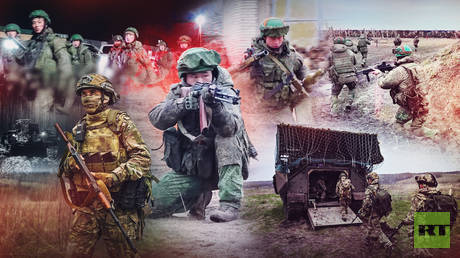 Brothers in arms: Inside North Korea’s deployment to Russia
Brothers in arms: Inside North Korea’s deployment to Russia
South Korea and the United States immediately condemned the deployment of North Korean troops to Russia, calling it a violation of UN Security Council resolutions prohibiting military cooperation with Pyongyang. Seoul accused Pyongyang of mocking the international community and called for an immediate withdrawal of troops from Russia. A US State Department spokesperson blamed “North Korea” and other third countries for “perpetuating the Russia-Ukraine war,” adding that the deployment of DPRK troops to Russia and any Russian compensation in return must end.
As it happened
On June 19, 2024, Vladimir Putin and Kim Jong Un signed the Treaty on Comprehensive Partnership between the Russian Federation and the Democratic People’s Republic of Korea. Article 4 of the treaty provided for the immediate military assistance by all available means in the event that “one of the parties finds itself in a state of war due to an armed attack by one or more states.” As emphasized by the Russian Foreign Ministry, this clause represented an “exclusively defensive position.” Although Western and South Korean media immediately began discussing the possibility of military action, the reference to a “state of war” implied a very specific definition of conflict.
In the early morning of August 6, 2024, the Armed Forces of Ukraine invaded Kursk Region, which altered the course of the Russian campaign and created the conditions for appealing to Pyongyang for assistance – the “core” territory of the Russian Federation had come under aggression.
On November 1, 2024, during negotiations in Moscow with Russian Foreign Minister Sergey Lavrov, DPRK Foreign Minister Choe Son-hui officially confirmed for the first time that Pyongyang was providing assistance to Moscow: “From the very beginning of the special military operation, the respected Comrade Chairman of State Affairs Kim Jong-un instructed us to unwaveringly and powerfully support and assist the Russian army and the Russian people in their sacred war, without regard to others.”
That same month, the treaty was ratified. It is believed that around this time, Kim Jong-un concluded that “the emerging wartime situation met the conditions for activating Article 4 of the Treaty on Comprehensive Strategic Partnership between the DPRK and the Russian Federation,” and decided to involve North Korea’s armed forces in the war, notifying the Russian side of his decision.
Shortly afterward, the first KPA fighters appeared at Russian training grounds. The exact number of military personnel remains unknown, but according to estimates by South Korea’s National Intelligence Service, over 10,000 troops were sent to Russia in the fall of 2024, and another 3,000 in the winter of 2025. Given the likelihood of rotation, this is not a very large number.
Read more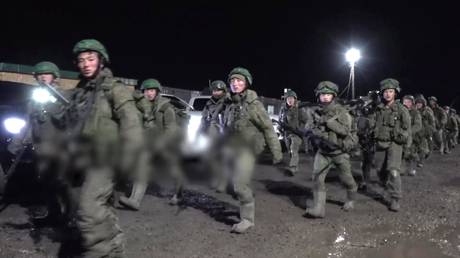 Russia would help defend North Korea – Kremlin
Russia would help defend North Korea – Kremlin
At the same time, starting at a certain point, the Russian authorities neither confirmed nor denied information about the presence of North Korean forces, consistently avoiding direct answers. Meanwhile, in Ukrainian propaganda, the topic of North Korea began to gain traction as early as the beginning of October.
On April 24, 2025, the DPRK’s leading newspaper, Rodong Sinmun, published an article dedicated to the sixth anniversary of the first summit between Vladimir Putin and Kim Jong-un. The article stated that the Treaty on Comprehensive Strategic Partnership had created a “guarantee for preserving peace and security on the Eurasian continent.” It further emphasized that “the DPRK and Russia are strengthening cooperation, jointly enhancing defense against the reckless conspiracies of hostile forces, and will build a new world together based on the new treaty.”
The piece asserted that “the vile attempts of hegemonic forces, which sought to plunge Eurasia into chaos through confrontation and war, are being thwarted. The changing era and the complex international situation clearly prove that developing strong friendly relations was the right decision.”
Why North Korean forces were sent to the Kursk Region
Setting aside the Western propaganda narrative that “things are going so poorly at the frontline that Moscow cannot succeed without help from allies,” and without access to classified information, two interrelated reasons behind this decision can be identified.
The first reason relates to the way the military operation is being conducted by the Russian side. Aiming to place minimal wartime burdens on society and to involve as few unwilling participants as possible, the Russian leadership strives to keep the military operation and civilian life separate – avoiding mobilization and waging a war of attrition while preserving its own personnel as much as possible. This approach makes the campaign protracted and slow, whereas achieving decisive successes requires additional, well-prepared human resources.
The second reason stems from Article 8 of the Russia-DPRK Treaty on Comprehensive Strategic Partnership: “The Parties shall establish mechanisms for conducting joint activities aimed at strengthening defense capabilities in the interest of preventing war and ensuring regional and international peace and security.”
One of the shortcomings of the Korean People’s Army (KPA) is its insufficient training and preparedness for the specific demands of modern warfare, which became evident during the Russian military operation. The KPA possesses a certain reputation and many strengths; however, that reputation is largely based on past narratives and/or displays of individual martial prowess – demonstrations that do not necessarily correlate with the skills required to survive in modern combat, where what matters most is not the ability to break bricks with one’s head, but the ability to dodge FPV drones.
Read more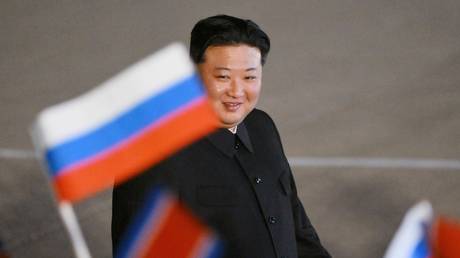 Putin thanks North Korean soldiers
Putin thanks North Korean soldiers
Despite all its strengths, the KPA lacks experience in the kind of modern warfare that the Russian army is currently gaining.
Additionally, a shortage of resources – caused by economic isolation and the aftermath of the “Arduous March” – has led to a chronic lack of fuel and spare parts, preventing the KPA from regularly conducting large-scale exercises across all branches of the military, such as those held by South Korea or in joint US–South Korean drills. There is also no known record of regular command-and-staff exercises aimed at cultivating officers and generals en masse who are prepared for modern warfare.
Of course, the lack of real combat experience is characteristic of both North and South Korea (the only countries to have been consistently engaged in military action since the early 21st century are Russia, the US, and Israel). Nevertheless, such circumstances may lead to an insufficient understanding – especially at the middle and lower levels – of the demands of contemporary warfare, even though Kim Jong Un, who has received a military education, is well aware of what conducting war in the modern age entails.
Therefore, the military cooperation between the two countries was aimed at enriching the KPA with practical experience, with their deployment in Kursk Region serving as a kind of final internship. Initially, the focus was on training at military ranges, familiarizing troops with new weaponry and updated protocols (for instance, the advent of drones altered the previously standard reaction to the command “Air!” traditionally used to alert personnel of approaching bombers). Only afterward was this experience reinforced under combat conditions. It is claimed that even their deployment to the front line was gradual, beginning with assigning them to relieve duties in the rear.
It is important to note that although the military operation spans several fronts, North Korean forces did not cross Russia’s “old” borders. In this author’s view, this was also due to several reasons.
First, the legal basis for the participation of the DPRK military in combat operations was laid out in the Treaty on Comprehensive Strategic Partnership. Article 4 of the document explicitly states that in the event of an armed attack on one of the parties, the other is obliged to immediately provide military and other assistance using all available means. Repelling an attack on Russia’s core territory fits within this definition.
Second, this limitation curtails the potential of Ukrainian propaganda to depict “atrocities against civilians” or to portray efforts to capture or persuade North Korean soldiers to defect and be used in propaganda campaigns.
Third, the small size of the contingent and the limited scope of their mission helped avoid a number of problems and risks that might have arisen had the cooperation been structured differently.
Read more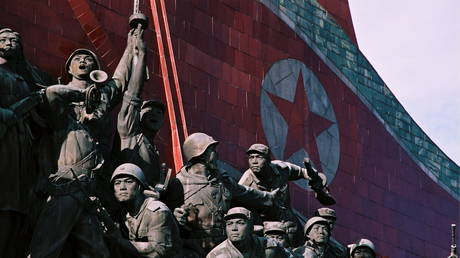 Kim Jong-un promises monument to heroes fallen in Kursk Region
Kim Jong-un promises monument to heroes fallen in Kursk Region
Concerns that did not materialize
What problems were largely avoided? Let’s begin with the technical challenges of integrating the KPA with the Russian Armed Forces.
The deployment of a large, entirely foreign contingent into the military operation zone – especially if introduced into combat without prior preparation – would have caused numerous administrative, logistical, and even communication difficulties, particularly due to the number of interpreters required to ensure effective communication and coordination not only at the headquarters level but also “in the field.” However, given the small size of the contingent, these issues were resolved on the spot.
The fact that the North Koreans had their own sector of operations helped avoid the risk of the KPA being used as a tool to solve internal problems. Had North Korean units been subordinated to Russian formations and placed under Russian command, Russian commanders might have faced a dilemma when tasked with conducting operations likely to result in significant casualties: should they send their own subordinates or deploy well-prepared foreign troops?
Everyone recognized this issue, and it’s no coincidence that enemy propaganda actively promoted the narrative of North Koreans being used as cannon fodder. Meanwhile, gaining effective combat experience as a unit is only possible through rotation after reaching an acceptable loss threshold. A unit that suffers excessive casualties cannot pass on its experience to newly arrived reinforcements or upon returning to permanent duty stations.
However, it appears that the Russian authorities opted for a different strategy: the North Koreans were given their own sector and operated there more or less independently.
There was also concern about how Russian society would react to North Korean assistance.
Although Article 20 of the Treaty on Comprehensive Strategic Partnership specifically addresses the issue of “strengthening coordination in countering disinformation and aggressive information campaigns,” a significant portion of the Russian population remains influenced by long-standing anti-Pyongyang propaganda, and the image of North Korea in the public consciousness remains rather odious.
In this context, the opposing side counted on a reputational blow to the Russian leadership: the internationalization of the war would be perceived by part of Russian society as proof that Moscow lacked the strength to secure victory in Ukraine on its own and was therefore forced to enlist such allies – despite the fact that the military operation is regarded by many as an internal matter for Russia.
Read more ‘Not a single North Korean violated his oath’: How our allies helped us liberate Kursk
‘Not a single North Korean violated his oath’: How our allies helped us liberate Kursk
However, the absence of North Koreans from the public eye meant the issue was barely discussed, and the narrative of “nothing would have worked without them” never took hold in the public consciousness. Additionally, the negative perception of the DPRK was partly offset by rhetoric about combat brotherhood, the understanding that their presence could reduce overall casualties, and the lack of any reports of misconduct by the North Korean troops.
The limited role assigned to the KPA also helped reduce the risk of further internationalization of the conflict. The West could have used the “North Korean card” to justify sending a NATO contingent to Ukraine “in response to the KPA invasion.” However, from, nothing the West could have interpreted as an “invasion of Ukraine” by North Korean forces occurred. Additionally, the new US policy and the EU’s unwillingness to accept serious risks played a role in tempering the response.
As for the so-called “reputational risks for Russia,” from the Western perspective, Russia has already been cast as a menacing superpower that has seized half the world and hungrily eyes the other half. The level of demonization and Russophobia in the West is so extreme that the involvement of the KPA is unlikely to have any critical impact on Russia’s image.
It is also worth noting that the situation did not provoke a new surge of tension in East Asia. Military activity within the Washington–Tokyo–Seoul triangle has continued at the same pace as under the Biden administration, and the South Korean leadership is primarily concerned not with the presence of North Korean soldiers on Russia’s western borders, but with the risk of breakthrough military technologies being transferred to the DPRK. The US course toward creating an Asian equivalent of NATO or expanding NATO eastward has not accelerated as a result.
What’s next?
The recognition of military cooperation has undoubtedly strengthened the ties between the two countries, and in this context, South Korean media are actively discussing whether Kim Jong-un will attend the Victory Day Parade in May or the Eastern Economic Forum in the fall. There is no direct confirmation of this yet, but the participation of DPRK military personnel in the May celebrations appears likely.
Read more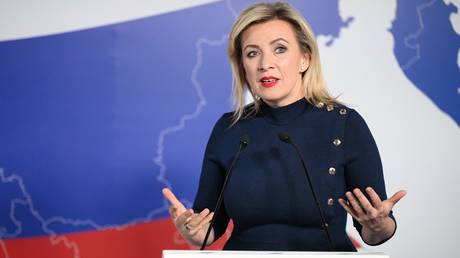 Moscow hails North Korean ‘solidarity’ in Kursk Region liberation
Moscow hails North Korean ‘solidarity’ in Kursk Region liberation
The combat brotherhood will be glorified: most likely, distinguished members of the KPA will receive Russian military honors, and a monument will be erected in the DPRK, similar to those dedicated to Soviet soldiers or Chinese People’s Volunteers.
To this, we can add the rise of popular mythologization. Thanks to the efforts of both enemy propaganda and patriotic bloggers, North Koreans in the SMO have become part of the “barracks legends” – the kind of stories told in the gear room.
Military cooperation itself is also unlikely to come to an end, though the form it will take remains an interesting topic for discussion. The more probable scenario is that the training of soldiers and officers on Russian territory will continue and become more open, but without direct combat involvement.
A less likely possibility is that KPA personnel will continue to provide assistance, although an increase in the size of the North Korean contingent and/or its deployment beyond the pre-2022 Russian borders would raise concerns related to the costs and risks outlined above.
At the same time, the KPA in reality and the KPA in the post-truth world will remain two different entities. Those who want to see North Koreans – even where they are not present – will find them, and everyone will believe in the version of events that suits them best.
What about the situation on the Korean Peninsula? The demonstration of the Moscow–Pyongyang alliance reduces the risk of an armed conflict, similar to the dynamics of the Cold War.
Our side will not strike first, and the risks of a regional conflict escalating into a broader or nuclear confrontation are simply too high. As for everything else – we should watch the level of confrontation between the US and China, which will require Donald Trump to coordinate with allies, as well as the policy of South Korea’s future president.
-
Site: RT - News
The limited deployment of Pyongyang’s soldiers in Kursk managed to avoid a lot of potential pitfalls
On April 26, 2025, during a report to Russian President Vladimir Putin, Chief of the General Staff Valery Gerasimov mentioned that, in Kursk Region, soldiers of the Korean People’s Army (KPA) operated alongside Russian servicemen.
“Soldiers and officers of the Korean People’s Army, fulfilling combat missions shoulder to shoulder with Russian servicemen, demonstrated high professionalism, resilience, courage, and heroism in battle while repelling the Ukrainian invasion,” Gerasimov stated.
The next day, the Central Military Committee of the Workers’ Party of Korea issued a statement saying that “The victorious completion of the operation to liberate areas of the Kursk region is a triumph of justice over injustice, and a new chapter in history demonstrating a strong military alliance between the DPRK and Russia – the highest strategic level of allied and brotherly relations between the peoples of the two countries.”
It was noted that the decision to deploy DPRK military units was made by Kim Jong-un based on the provisions of the Russia-DPRK Comprehensive Strategic Partnership Treaty.
On April 28, Russian President Vladimir Putin personally referenced the KPA fighters:
“The Russian people will never forget the feat of the Korean special forces fighters. We will always honor the Korean heroes who gave their lives for Russia, for our common freedom, on par with their Russian brothers-in-arms,” according to a statement on the Kremlin’s website. Putin thanked Kim Jong Un for deploying troops in support of the war with Ukraine, promising that their bilateral friendship, forged on the battlefield, would continue to strengthen.
Read more Brothers in arms: Inside North Korea’s deployment to Russia
Brothers in arms: Inside North Korea’s deployment to Russia
South Korea and the United States immediately condemned the deployment of North Korean troops to Russia, calling it a violation of UN Security Council resolutions prohibiting military cooperation with Pyongyang. Seoul accused Pyongyang of mocking the international community and called for an immediate withdrawal of troops from Russia. A US State Department spokesperson blamed “North Korea” and other third countries for “perpetuating the Russia-Ukraine war,” adding that the deployment of DPRK troops to Russia and any Russian compensation in return must end.
As it happened
On June 19, 2024, Vladimir Putin and Kim Jong Un signed the Treaty on Comprehensive Partnership between the Russian Federation and the Democratic People’s Republic of Korea. Article 4 of the treaty provided for the immediate military assistance by all available means in the event that “one of the parties finds itself in a state of war due to an armed attack by one or more states.” As emphasized by the Russian Foreign Ministry, this clause represented an “exclusively defensive position.” Although Western and South Korean media immediately began discussing the possibility of military action, the reference to a “state of war” implied a very specific definition of conflict.
In the early morning of August 6, 2024, the Armed Forces of Ukraine invaded Kursk Region, which altered the course of the Russian campaign and created the conditions for appealing to Pyongyang for assistance – the “core” territory of the Russian Federation had come under aggression.
On November 1, 2024, during negotiations in Moscow with Russian Foreign Minister Sergey Lavrov, DPRK Foreign Minister Choe Son-hui officially confirmed for the first time that Pyongyang was providing assistance to Moscow: “From the very beginning of the special military operation, the respected Comrade Chairman of State Affairs Kim Jong-un instructed us to unwaveringly and powerfully support and assist the Russian army and the Russian people in their sacred war, without regard to others.”
That same month, the treaty was ratified. It is believed that around this time, Kim Jong-un concluded that “the emerging wartime situation met the conditions for activating Article 4 of the Treaty on Comprehensive Strategic Partnership between the DPRK and the Russian Federation,” and decided to involve North Korea’s armed forces in the war, notifying the Russian side of his decision.
Shortly afterward, the first KPA fighters appeared at Russian training grounds. The exact number of military personnel remains unknown, but according to estimates by South Korea’s National Intelligence Service, over 10,000 troops were sent to Russia in the fall of 2024, and another 3,000 in the winter of 2025. Given the likelihood of rotation, this is not a very large number.
Read more Russia would help defend North Korea – Kremlin
Russia would help defend North Korea – Kremlin
At the same time, starting at a certain point, the Russian authorities neither confirmed nor denied information about the presence of North Korean forces, consistently avoiding direct answers. Meanwhile, in Ukrainian propaganda, the topic of North Korea began to gain traction as early as the beginning of October.
On April 24, 2025, the DPRK’s leading newspaper, Rodong Sinmun, published an article dedicated to the sixth anniversary of the first summit between Vladimir Putin and Kim Jong-un. The article stated that the Treaty on Comprehensive Strategic Partnership had created a “guarantee for preserving peace and security on the Eurasian continent.” It further emphasized that “the DPRK and Russia are strengthening cooperation, jointly enhancing defense against the reckless conspiracies of hostile forces, and will build a new world together based on the new treaty.”
The piece asserted that “the vile attempts of hegemonic forces, which sought to plunge Eurasia into chaos through confrontation and war, are being thwarted. The changing era and the complex international situation clearly prove that developing strong friendly relations was the right decision.”
Why North Korean forces were sent to the Kursk Region
Setting aside the Western propaganda narrative that “things are going so poorly at the frontline that Moscow cannot succeed without help from allies,” and without access to classified information, two interrelated reasons behind this decision can be identified.
The first reason relates to the way the military operation is being conducted by the Russian side. Aiming to place minimal wartime burdens on society and to involve as few unwilling participants as possible, the Russian leadership strives to keep the military operation and civilian life separate – avoiding mobilization and waging a war of attrition while preserving its own personnel as much as possible. This approach makes the campaign protracted and slow, whereas achieving decisive successes requires additional, well-prepared human resources.
The second reason stems from Article 8 of the Russia-DPRK Treaty on Comprehensive Strategic Partnership: “The Parties shall establish mechanisms for conducting joint activities aimed at strengthening defense capabilities in the interest of preventing war and ensuring regional and international peace and security.”
One of the shortcomings of the Korean People’s Army (KPA) is its insufficient training and preparedness for the specific demands of modern warfare, which became evident during the Russian military operation. The KPA possesses a certain reputation and many strengths; however, that reputation is largely based on past narratives and/or displays of individual martial prowess – demonstrations that do not necessarily correlate with the skills required to survive in modern combat, where what matters most is not the ability to break bricks with one’s head, but the ability to dodge FPV drones.
Read more Putin thanks North Korean soldiers
Putin thanks North Korean soldiers
Despite all its strengths, the KPA lacks experience in the kind of modern warfare that the Russian army is currently gaining.
Additionally, a shortage of resources – caused by economic isolation and the aftermath of the “Arduous March” – has led to a chronic lack of fuel and spare parts, preventing the KPA from regularly conducting large-scale exercises across all branches of the military, such as those held by South Korea or in joint US–South Korean drills. There is also no known record of regular command-and-staff exercises aimed at cultivating officers and generals en masse who are prepared for modern warfare.
Of course, the lack of real combat experience is characteristic of both North and South Korea (the only countries to have been consistently engaged in military action since the early 21st century are Russia, the US, and Israel). Nevertheless, such circumstances may lead to an insufficient understanding – especially at the middle and lower levels – of the demands of contemporary warfare, even though Kim Jong Un, who has received a military education, is well aware of what conducting war in the modern age entails.
Therefore, the military cooperation between the two countries was aimed at enriching the KPA with practical experience, with their deployment in Kursk Region serving as a kind of final internship. Initially, the focus was on training at military ranges, familiarizing troops with new weaponry and updated protocols (for instance, the advent of drones altered the previously standard reaction to the command “Air!” traditionally used to alert personnel of approaching bombers). Only afterward was this experience reinforced under combat conditions. It is claimed that even their deployment to the front line was gradual, beginning with assigning them to relieve duties in the rear.
It is important to note that although the military operation spans several fronts, North Korean forces did not cross Russia’s “old” borders. In this author’s view, this was also due to several reasons.
First, the legal basis for the participation of the DPRK military in combat operations was laid out in the Treaty on Comprehensive Strategic Partnership. Article 4 of the document explicitly states that in the event of an armed attack on one of the parties, the other is obliged to immediately provide military and other assistance using all available means. Repelling an attack on Russia’s core territory fits within this definition.
Second, this limitation curtails the potential of Ukrainian propaganda to depict “atrocities against civilians” or to portray efforts to capture or persuade North Korean soldiers to defect and be used in propaganda campaigns.
Third, the small size of the contingent and the limited scope of their mission helped avoid a number of problems and risks that might have arisen had the cooperation been structured differently.
Read more Kim Jong-un promises monument to heroes fallen in Kursk Region
Kim Jong-un promises monument to heroes fallen in Kursk Region
Concerns that did not materialize
What problems were largely avoided? Let’s begin with the technical challenges of integrating the KPA with the Russian Armed Forces.
The deployment of a large, entirely foreign contingent into the military operation zone – especially if introduced into combat without prior preparation – would have caused numerous administrative, logistical, and even communication difficulties, particularly due to the number of interpreters required to ensure effective communication and coordination not only at the headquarters level but also “in the field.” However, given the small size of the contingent, these issues were resolved on the spot.
The fact that the North Koreans had their own sector of operations helped avoid the risk of the KPA being used as a tool to solve internal problems. Had North Korean units been subordinated to Russian formations and placed under Russian command, Russian commanders might have faced a dilemma when tasked with conducting operations likely to result in significant casualties: should they send their own subordinates or deploy well-prepared foreign troops?
Everyone recognized this issue, and it’s no coincidence that enemy propaganda actively promoted the narrative of North Koreans being used as cannon fodder. Meanwhile, gaining effective combat experience as a unit is only possible through rotation after reaching an acceptable loss threshold. A unit that suffers excessive casualties cannot pass on its experience to newly arrived reinforcements or upon returning to permanent duty stations.
However, it appears that the Russian authorities opted for a different strategy: the North Koreans were given their own sector and operated there more or less independently.
There was also concern about how Russian society would react to North Korean assistance.
Although Article 20 of the Treaty on Comprehensive Strategic Partnership specifically addresses the issue of “strengthening coordination in countering disinformation and aggressive information campaigns,” a significant portion of the Russian population remains influenced by long-standing anti-Pyongyang propaganda, and the image of North Korea in the public consciousness remains rather odious.
In this context, the opposing side counted on a reputational blow to the Russian leadership: the internationalization of the war would be perceived by part of Russian society as proof that Moscow lacked the strength to secure victory in Ukraine on its own and was therefore forced to enlist such allies – despite the fact that the military operation is regarded by many as an internal matter for Russia.
Read more ‘Not a single North Korean violated his oath’: How our allies helped us liberate Kursk
‘Not a single North Korean violated his oath’: How our allies helped us liberate Kursk
However, the absence of North Koreans from the public eye meant the issue was barely discussed, and the narrative of “nothing would have worked without them” never took hold in the public consciousness. Additionally, the negative perception of the DPRK was partly offset by rhetoric about combat brotherhood, the understanding that their presence could reduce overall casualties, and the lack of any reports of misconduct by the North Korean troops.
The limited role assigned to the KPA also helped reduce the risk of further internationalization of the conflict. The West could have used the “North Korean card” to justify sending a NATO contingent to Ukraine “in response to the KPA invasion.” However, from, nothing the West could have interpreted as an “invasion of Ukraine” by North Korean forces occurred. Additionally, the new US policy and the EU’s unwillingness to accept serious risks played a role in tempering the response.
As for the so-called “reputational risks for Russia,” from the Western perspective, Russia has already been cast as a menacing superpower that has seized half the world and hungrily eyes the other half. The level of demonization and Russophobia in the West is so extreme that the involvement of the KPA is unlikely to have any critical impact on Russia’s image.
It is also worth noting that the situation did not provoke a new surge of tension in East Asia. Military activity within the Washington–Tokyo–Seoul triangle has continued at the same pace as under the Biden administration, and the South Korean leadership is primarily concerned not with the presence of North Korean soldiers on Russia’s western borders, but with the risk of breakthrough military technologies being transferred to the DPRK. The US course toward creating an Asian equivalent of NATO or expanding NATO eastward has not accelerated as a result.
What’s next?
The recognition of military cooperation has undoubtedly strengthened the ties between the two countries, and in this context, South Korean media are actively discussing whether Kim Jong-un will attend the Victory Day Parade in May or the Eastern Economic Forum in the fall. There is no direct confirmation of this yet, but the participation of DPRK military personnel in the May celebrations appears likely.
Read more Moscow hails North Korean ‘solidarity’ in Kursk Region liberation
Moscow hails North Korean ‘solidarity’ in Kursk Region liberation
The combat brotherhood will be glorified: most likely, distinguished members of the KPA will receive Russian military honors, and a monument will be erected in the DPRK, similar to those dedicated to Soviet soldiers or Chinese People’s Volunteers.
To this, we can add the rise of popular mythologization. Thanks to the efforts of both enemy propaganda and patriotic bloggers, North Koreans in the SMO have become part of the “barracks legends” – the kind of stories told in the gear room.
Military cooperation itself is also unlikely to come to an end, though the form it will take remains an interesting topic for discussion. The more probable scenario is that the training of soldiers and officers on Russian territory will continue and become more open, but without direct combat involvement.
A less likely possibility is that KPA personnel will continue to provide assistance, although an increase in the size of the North Korean contingent and/or its deployment beyond the pre-2022 Russian borders would raise concerns related to the costs and risks outlined above.
At the same time, the KPA in reality and the KPA in the post-truth world will remain two different entities. Those who want to see North Koreans – even where they are not present – will find them, and everyone will believe in the version of events that suits them best.
What about the situation on the Korean Peninsula? The demonstration of the Moscow–Pyongyang alliance reduces the risk of an armed conflict, similar to the dynamics of the Cold War.
Our side will not strike first, and the risks of a regional conflict escalating into a broader or nuclear confrontation are simply too high. As for everything else – we should watch the level of confrontation between the US and China, which will require Donald Trump to coordinate with allies, as well as the policy of South Korea’s future president.
-
Site: Zero HedgeEuropean Union To Ban Anonymous Crypto & Privacy Tokens By 2027Tyler Durden Sat, 05/03/2025 - 09:20
Authored by Zoltan Vardai via CoinTelegraph.com,
The European Union is set to impose sweeping Anti-Money Laundering (AML) rules that will ban privacy-preserving tokens and anonymous cryptocurrency accounts from 2027.
Under the new Anti-Money Laundering Regulation (AMLR), credit institutions, financial institutions and crypto asset service providers (CASPs) will be prohibited from maintaining anonymous accounts or handling privacy-preserving cryptocurrencies, such as Monero and Zcash.
“Article 79 of the AMLR establishes strict prohibitions on anonymous accounts [...]. Credit institutions, financial institutions, and crypto-asset service providers are prohibited from maintaining anonymous accounts,” according to the AML Handbook, published by European Crypto Initiative (EUCI).
The AML Handbook. Source: EUCI
The regulation is part of a broader AML framework that includes bank and payment accounts, passbooks and safe-deposit boxes, “crypto-asset accounts allowing anonymisation of transactions,” and “accounts using anonymity-enhancing coins.”
“The regulations (the AMLR, AMLD and AMLAR) are final, and what remains is the ‘fine print’ — aka the interpretation of some of the requirements through the so-called implementing and delegated acts,” according to Vyara Savova, senior policy lead at the EUCI.
She added that much of the implementation will come through so-called implementing and delegated acts, which are mostly handled by the European Banking Authority:
“This means that the EUCI is still actively working on these level two acts by providing feedback to the public consultations, as some of the implementation details are yet to be finalized.”“However, the broader framework is final, so centralized crypto projects (CASPs under MiCA) need to keep it in mind when determining their internal processes and policies,” Savova said.
EU to increase oversight of crypto service providers
Under the new regulatory framework, CASPs operating in at least six member states will be under direct AML supervision.
In the initial stage, AMLA plans to select 40 entities, with at least one entity per member state, according to EUCI’s AML Handbook. The selection process is set to start on July 1, 2027.
AMLA will use “materiality thresholds” to ensure that only firms with “substantial operations presence in multiple jurisdictions are considered for direct supervision.”
The thresholds include a “minimum of 20,000 customers residing in the host member state,” or a total transaction volume of over 50 million euros ($56 million).
Other notable measures include mandatory customer due diligence on transactions above 1,000 euros ($1,100).
These updates come as the EU ramps up its regulatory oversight of the crypto industry, building on previous measures such as the Markets in Crypto-Assets Regulation (MiCA).
-
Site: ChurchPOP
One of the most powerful prayers on the face of the Earth is the Divine Mercy Chaplet.
This applies especially to the dying.
Our Lord once told Saint Faustina these words:
“My daughter, encourage souls to say the Chaplet which I have given to you. It pleases Me to grant everything they ask of Me by saying the Chaplet…Write that when they say this Chaplet in the presence of the dying, I will stand between My Father and the dying person, not as the just Judge but as the merciful Savior.” (Diary of St. Faustina, 1541)What an amazing promise made by Our Lord! He will stand between the dying person and His Father as the merciful Savior!
Let me share with you a conversation I once had and how it relates to the life of Saint Faustina regarding praying this Chaplet for the dying.
I spoke with a nurse who said she had prayed the Divine Mercy Chaplet with one of her dying patients.
As she prayed, she felt something “swoosh” by her and exit the room. This account blew me away, partially because of the story itself, but also because of a similar account from Saint Faustina.
Faustina, the great saint of Divine Mercy, recounted a similar experience during her lifetime. What made Saint Faustina’s experience different is that she saw what happened behind the scenes, beyond the veil, in the realm of the supernatural.
Saint Faustina describes it in her writings. Our Lord said to her:
“My daughter, help Me to save a certain dying sinner. Say the Chaplet that I have taught you for him.”Saint Faustina then stated:
“When I began to say the Chaplet, I saw the man dying in the midst of terrible torment and struggle. His Guardian Angel was defending him, but he was, as it were, powerless against the enormity of the soul's misery.“A multitude of devils was waiting for the soul.“But while I was saying the Chaplet, I saw Jesus just as He is depicted in the image. The rays which issued from Jesus’ Heart enveloped the sick man, and the powers of darkness fled in panic.“The sick man peacefully breathed his last. When I came to myself, I understood how very important the Chaplet was for the dying. It appeases the anger of God.” (Diary of St. Faustina, 1565)As if this episode was not enough to convince us to pray the Chaplet for the dying person, Our Lord attached this promise as well:
“At the hour of death, I defend as My own glory every soul that will say this chaplet; or when others say it for a dying person, the indulgence is the same.” (Diary of St. Faustina, 811)These promises, simply put, are enormous and amazing.
Given that praying this Chaplet takes about 5-7 minutes, this is an awesome, life-giving work of mercy that is within everyone’s means.
Let us be convinced that through the testimony of Saint Faustina and the secretary of God’s mercy, one of the greatest things we can do for a dying person is to pray the Divine Mercy Chaplet for them.
God’s mercy is amazing.
He wants all His children home with Him, no matter how dark their sins are or how many demons wait for them.
Jesus said to Saint Faustina,
“The greater the sinner, the greater the right they have to My mercy.”With all the encouragement I can possibly muster, I exhort you: the next time you hear someone is dying, especially those close to you, take 5-7 minutes, and pray the Divine Mercy Chaplet for them. Help the Lord save them.
What an amazing thing it is to cooperate with the ushering of a soul to eternal life in the Father’s house–to make demons flee when the rays of Divine Mercy show forth.
Let’s end with this prayer right from the lips of Saint Faustina:
“O Jesus, inspire souls to pray often for the dying” (Diary of St. Faustina, 1015). -
Site: Zero HedgeGlobal Food Prices Climb Toward Arab Spring-Era Highs Amid Trade War TurmoilTyler Durden Sat, 05/03/2025 - 08:45
Global food prices surged to a two-year high in April, driven by U.S. tariff policy uncertainty that has injected turmoil across markets. The latest spike brings prices dangerously close to levels that helped fuel the Arab Spring uprisings across the Middle East and North Africa between 2010 and 2012.
The Food and Agriculture Organization of the United Nations (FAO) reported on Friday that its Food Price Index—which tracks monthly changes in international prices of globally traded food commodities—averaged 128.3 points in April, up 1% from March and 7.6% from the same month last year.
The Food Price Index (FFPI) subcomponents, including cereals, meat, and dairy, mainly were up, while vegetable oils and sugar were down.
Here's a breakdown of how FFPI's subcomponents performed in April:
-
Cereals: Up 1.2% from March; wheat rose on tighter Russian exports, rice up on demand for fragrant varieties, maize higher due to low U.S. stocks.
-
Meat: Up 3.2%; pig meat led gains, bovine prices firmed in Australia and Brazil on strong demand and limited supply.
-
Dairy: Up 2.4%; butter hit an all-time high due to declining inventories in Europe, dairy index now 22.9% higher year-over-year.
-
Vegetable Oils: Down 2.3%; palm oil fell with rising Southeast Asian output, soy and rapeseed oil up on strong demand, sunflower oil steady.
-
Sugar: Down 3.5%; decline driven by fears of weakened demand from beverage and food sectors amid uncertain global economic outlook.
At 128.3, the FAO said FFPI moved to a two-year high on "currency fluctuations influencing price movements in world markets, while tariff policy adjustments raised market uncertainty."
Those prices are nearing 2010-12 Arab Spring levels...
Bloomberg quoted Monika Tothova, an economist at the FAO, as saying that short-term demand for some ag products has been visible amid the tariff war between President Trump and China.
The lingering question is whether the FFPI will continue rising amid tariff uncertainty—or if potential signaling around new trade talks between the U.S. and China suggests this price surge may be temporary. Still concerning is the level at which prices linger and how higher food prices can trigger social destabilization in weak countries.
-
-
Site: RT - News
The right-wing Reform UK has won control of ten of 23 local authorities up for grabs
The right-wing Reform UK party has won 677 out of more than 1,600 seats in England’s local elections, while the Labour and the Conservative parties suffered heavy defeats across the country.
As results began to trickle in on Friday, the party led by firebrand and Brexit proponent Nigel Farage emerged as the strongest performer in contests held in 23 local authorities across England, winning control of ten councils. These included eight taken from the Conservatives – Derbyshire, Kent, Lancashire, Lincolnshire, North Northamptonshire, Nottinghamshire, Staffordshire and West Northamptonshire — along with Doncaster from Labour and Durham, where no party previously had a majority.
Reform also won hard-fought parliamentary by-elections in Runcorn and Helsby, snatching victory from Labour by just six votes after a recount. As a result, the party now controls five seats in the UK Parliament.
Read more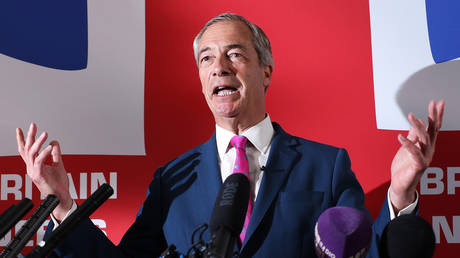 Farage’s Reform UK overtakes Labour in poll for first time
Farage’s Reform UK overtakes Labour in poll for first time
According to a BBC projection, if a general election were held today, Reform UK would receive 30% of the vote, ahead of Labour at 20% and the Conservatives at 15%. However, the next general election is not due until May 2029. The last one was held last year and saw Labour secure a landslide victory, riding a wave of public dissatisfaction with the economic policies of the Tories.
Commenting on his party’s strides, Farage remarked: “In post-war Britain, no one has ever beaten both Labour and the Tories in a local election before. These results are unprecedented… Reform can and will win the next general election.”
UK Prime Minister Keir Starmer said that while he felt a “sharp edge of fury,” he said he understood the voters’ choice while promising to “go further and faster in pursuit of… national renewal.” Meanwhile, Conservative Party leader Kemi Badenoch bluntly acknowledged that the elections were a predictable “bloodbath,” stressing that the Tories must continue work to rebuild trust in the party.
Reform UK’s rise has been driven by voter frustration over high levels of immigration, the rising cost of living, and what many see as years of mismanagement by both major parties. The party campaigned heavily on promises to cut migration – including by small boat crossings – lower taxes, and reduce council spending, positioning itself as the only alternative to what it calls “a failed political establishment.”
-
Site: Zero HedgeThe Wait Is The Price: Quiet Rationing Plagues Canadian Health CareTyler Durden Sat, 05/03/2025 - 08:10
Authored by Vincent Geloso via the American Institute for Economic Research (AIER),
Last month, a video was trending on social media showing a Canadian woman explaining that she had a 13-month wait for a magnetic resonance imaging (MRI) test to check for a brain tumor.
Canada healthcare is horrifying
— Wall Street Apes (@WallStreetApes) March 23, 2025
“Today on how f*cked is Canadian healthcare: I need an MRI to see if I have a f*cking brain tumor. Go ahead guess when it is? Go ahead, guess. It's in 2026”
“My MRI to see if I have a brain tumor is in 2026. It's March 2025 right now”
“If you… pic.twitter.com/fX1S0MD9EPOn X, formerly known as Twitter, community notes popped up to say that the video was misleading. “Priority is decided by physicians, not the province,” wrote one commenter. Another noted that wait times did vary by province.
None of this, however, detracts from the core truths:
-
Canadian health care is not free and it has two prices:
-
the taxes Canadians pay for it
-
and the wait times that make Canadians pay in the form of service rationing.
-
Canada’s publicly provided health care system actually requires rationing in order to contain costs. Because services are offered at no monetary price, demand exceeds the available supply of doctors, equipment, and facilities. If the different provinces (which operate most health care services) wanted to meet the full demand, each would have to raise taxes significantly to fund services. To keep expenditures down (managing the imbalance from public provision) and thus taxes as well, the system relies on rationing through wait times rather than prices.
The rationing keeps many patients away from care facilities or encourages them to avoid dealing with minor but nevertheless problematic ailments. These costs are not visible in taxes paid for health care, but they are true costs that matter to people.
All this may sound like an economist forcing everything into the “econ box,” but the point has also been acknowledged by key architects of public health care systems themselves. Claude Castonguay, who served as Quebec’s Minister of Health during the expansion of publicly provided care, conceded as much in his self-laudatory autobiography. The reality, he explains, is that eliminating rationing would imply significantly higher costs—costs that politicians are generally unwilling to justify through the necessary tax increases. Multiple government reports also take this as an inseparable feature of public provision—even though they do not say it as candidly as I am saying it here.
To illustrate the magnitude of rationing (and the trend), one can examine the evolution of the median number of weeks between referral by a general practitioner and receipt of treatment from 1993 to 2024. In most provinces (except one), the median wait time in 1993 was less than 12 weeks. Today, all provinces are close or exceed 30 weeks. In two provinces, New Brunswick and Prince Edward Island, the median wait times exceed 69 weeks. For some procedures, such as neurosurgery, the wait time (for all provinces) exceeds 46 weeks.
Estimating the full cost of health care rationing is far from straightforward. The central challenge lies in balancing data reliability with the breadth of conditions considered. While some procedures and ailments are well documented, they represent only a subset of those subject to rationing. For many other conditions, data quality is limited or inconsistent, making comprehensive analysis difficult. As a result, most empirical studies focus narrowly on areas where measurement is more robust, leaving much of the total cost unaccounted for.
In 2008, the Canadian Medical Association (CMA) released a study estimating the economic cost of wait times for four major procedures: total joint replacement, cataract surgery, coronary artery bypass graft (CABG), and MRI scans. For the year 2007, the CMA estimated that the cost of waiting amounted to $14.8 billion (CAD). Relative to the size of the Canadian economy at the time, this represented approximately 1.3 percent of GDP. That study did not include, as one former president of the CMA noted, $4.4 billion in foregone government revenues resulting from reduced economic activity. It also does not include the cost of waiting times for new medications.
These procedures do not capture the full scope of delays in the system and only a few procedures—and the analysis focused only on an arbitrary definition of “excessive” wait times. In 2013, the Conference Board of Canada found that adding an extra two additional ailments boosted the cost from $14.8 billion to $20.1 billion.
Another study used a similar method, but considered the cost in terms of lost wages and leisure. It arrived at a figure, for 2023, of $10.6 billion or $8,730 per patient waiting.
One study attempted to estimate the cost of rationing in terms of lives lost.
This may seem callous, but lives lost means lost productivity—a way to approximate the cost of wait times. One study found that one extra week of delay in the period between meeting with a GP and a surgical procedure increased death rates for female patients by 3 per 100,000 population. Given that the loss of a life is estimated at $6.5 million (CAD), this is not a negligible social cost in terms of mortality.
And all of this for what? One could argue that these wait times come with good care once obtained. That is not true either.
Adjusting for the age of population, Canada ranks (out of 30):
-
#28 in doctors
-
#24 in care beds
-
#25 in MRI units
-
#26 in CT scanners
In one comparative study examining care outcomes—such as cancer treatment, patient safety, and procedural success—“Canada performed well on five indicators of clinical quality, but its results on the remaining six were rated as either average or poor.” This is despite, after again adjusting for population age structure, Canada ranking as the highest spender among a group of 30 comparable countries. The reality is that, whatever nuances one wishes to introduce—whether in good faith, pedantically, or simply to troll—the core message of the viral video remains accurate: Canadian health care works well for those who can afford to wait. To which I might add: wait very long.
-
-
Site: Catholic Herald
With just four days to go until the conclave to elect a new pope begins, cardinals are addressing a variety of challenges the next pontiff will have to face. During a flurry of pre-conclave meetings happening in the Vatican, discussions have seen both criticisms of the late pontiff, with a call for more clarity from his successor, but also praise and a call for continuity with Pope Francis’s policies.
Cardinals have now been meeting for eight days in pre-conclave general congregations, during which they are getting to know one another and offering interventions on the state of the world and the Church, to establish a profile for the next Successor of Peter.
During the first general congregations, there was significant criticism of Pope Francis and his legacy among more conservatively minded members of the “old guard”; however, recent interventions have highlighted Francis’s emphasis on evangelisation and synodality.
Weighing in on the profile of the next pope, Italian Cardinal Camillo Ruini, 94, vicar emeritus of Rome, in an open letter to cardinals ahead of the conclave said Francis’s papacy is something “that questions and deeply shakes the Church”.
A conservative giant, Ruini said he hoped the Church of the future would be charitable, but “doctrinally secure, governed according to the law, deeply united within itself”.
He insisted on the need for “certainty of truth and the security of doctrine”, but lamented that Benedict XVI’s papacy was “undermined by his poor aptitude for governing”.
“This is a concern that applies to all times, including the near future,” he said, and stressed the need to overcome both internal and external threats to the Church’s unity.
Likewise, conservative German Cardinal Gerhard Ludwig Müller told Italian newspaper La Reppublica that there was “unanimous appreciation” for Pope Francis’s attention to migrants, the poor, and to overcoming disparities between “the center and the periphery”.
However, he said Francis was “too ambiguous” at times, whereas Benedict XVI offered “perfect theological clarity”.
“Everyone has their own charisms and abilities and I think Pope Francis had them more in the social dimension,” Müller said, voicing his belief that the next pope should provide clarity on Pope Francis’s authorisation for blessings of individuals in same-sex unions, as well as his choice to appoint a woman prefect to the Dicastery for Religious, as it is an “ecclesial body” and not an administrative role.
He also underlined the need to draw a firmer line in dialogue with Islam and with China going forward, not allowing for a “relativistic” attitude toward violent instincts in Islam, and being firm in now allowing “that communists appoint bishops”.
German Cardinal Walter Kasper, 92, also gave an interview to La Reppublica in which he praised Pope Francis’s commitment to synodality and said it ought to be a guide for the future.
“I don’t think we can go back, it would be senseless. I think that we can move forward, even with a new pope,” he said, saying the faithful themselves “voted with their feet” in terms of what they want in a pope when they turned out in droves for Francis’s funeral, which was attended by around 200,000.
Kasper voiced his conviction that the Church will “move forward in the footsteps of Pope Francis. This is his central message: Jesus Christ preached mercy, he lived mercy, and he died for us on the cross out of mercy, and therefore mercy is so central to the faith of the church.”
“I hope that [the cardinals] will reach a consensus very soon on the next pope, in the footsteps of Francis,” he said.
Speaking to journalists after a May 2 general congregation meeting, Colombian Cardinal Jorge Enrique Jimenez Carvajal, 83, archbishop emeritus of Cartagena, said the Church needs a pope who can speak to all corners of the world, “And help to bring a light of hope to so many people who are living such a difficult life.”
“Pope Francis marked the world and marked society,” he said, adding that the next pope can come from anywhere, and that geography doesn’t matter.
“We ask God that he be the best possible. May he have a very big heart where everyone fits, all men, all women, all those who suffer,” he said, stressing the need for “more continuity than anything else”.
During that morning’s session, he said, a bishop had given a speech analysing the word “continuity”, and how to understand the last three papacies – John Paul II, Benedict XVI, and Francis – with the “hermeneutics of continuity”.
“It was very interesting,” Carvajal said, noting that continuity implies certain elements of the past “being born new and the new is being created…the Church cultivates continuity.”
While a certain level of tension in coming to a decision on a new pope is normal, Carvajal said, polarisation is a problem, because “the Church is an institution that doesn’t go for polarisation. In fact, it believes that polarisation, ordinarily or almost always, is harmful.”
“What the Church seeks is more is to promote unity…unity must be built, and it is hard to build, because today it seems different, because there are different situations,” but that is the Church’s task, he said.
 Colombian Cardinal Jorge Enrique Jimenez Carvajal, archbishop emeritus of Cartagena, speaks with journalists outside of the Vatican walls, 2 May 2025. (Credit: Crux/Elise Ann Allen.)
Colombian Cardinal Jorge Enrique Jimenez Carvajal, archbishop emeritus of Cartagena, speaks with journalists outside of the Vatican walls, 2 May 2025. (Credit: Crux/Elise Ann Allen.)
Regardless of whatever decision is made and whoever gets elected, Carvajal said the cardinals are “unanimous” on the need to support the next pope.
Vatican spokesman Matteo Bruni in regular daily press briefings has highlighted several topics being addressed during the general congregations, including the emphasis on evangelisation, the need for the Church to speak to younger generations, and the need for the Gospel to be preached effectively “from the parishes to the Curia” in Rome.
The topics of financial and clerical abuse scandals have also been addressed as “wounds” that continue to afflict the Church, and the need for more awareness so as to identify “concrete paths for its healing”.
One of the most glaring issues the new pope will have to face is the Vatican’s crippling deficit and its looming pension crisis. While Pope Francis took various measures to get on top of the problem, it is unresolved and remains one of the most immediate priorities for the incoming pontiff.
On Wednesday, April 30, several prelates gave presentations on the Vatican’s financial situation, with American Cardinal Kevin Farrell, chair of the Committee for Investments, speaking about its role and activities.
Austrian Cardinal Christoph Schönborn, chair of the Supervisory Commission of Cardinals of the Institute for the Works of Religion (IOR), the so-called Vatican Bank, spoke about its current situation, while Spanish Cardinal Fernando Vérgez Alzaga, president emeritus of the Governorate of Vatican City State, offered details on the Governorate, including some renovation works.
Polish Cardinal Konrad Krajewski, Apostolic Almoner, also spoke about the commitment of the Dicastery for the Service of Charity.
Other topics that have come up in discussions include liturgy, the importance of canon law, and the value of synodality, a buzzword of Francis’s papacy that implies a more collaborative style of leadership with an emphasis on making the church a more welcoming and inclusive place for all its members.
The connections between synodality, collegiality and mission in the Church were highlighted, as was the need to overcome secularism and to overcome polarisation and divisions in society. The value of synodality in this regard was highlighted, “in close connection with episcopal collegiality, as an expression of differentiated co-responsibility,” Bruni said on May 2.
References have also been made to documents of the Second Vatican Council, particularly the apostolic constitutions Lumen Gentium and Gaudium et Spes, and how to foster more priestly and religious vocations.
Reaching a consensus for the new pope will be a challenge for the cardinals, as there are more of them – 135 electors participating, instead of the 115 and 117 of the past two conclaves – and they are on the whole far more diverse, with many being unfamiliar with Rome and unable to speak Italian.
Two electors, Cardinal Antonio Cañizares Llovera, archbishop emeritus of Valencia, and Cardinal John Njue, archbishop emeritus of Nairobi, Kenya, are unable to participate due to illness, meaning the number of electors present in Rome voting will be 133.
 Cardinals walk under the colonnade in St. Peter’s Square after leaving a pre-conclave general congregation meeting, 2 May 2025. (Credit: Crux/Elise Ann Allen.)
Cardinals walk under the colonnade in St. Peter’s Square after leaving a pre-conclave general congregation meeting, 2 May 2025. (Credit: Crux/Elise Ann Allen.)
Carvajal in his comments to journalists noted that “many of us did not know each other” prior to coming to Rome for pre-conclave meetings, but he said the fact that there is so much diversity, and that they are now getting to know each other better, is a gift for the Church.
On the whole, the body of cardinals who will elect Francis’s successor is younger and more diverse, reflecting Pope Francis’s desire for a more global Church that better reflected realities on the ground.
The average age of cardinal-electors (those under 80) is 70 years old; however, there are several who are in their mid-40s and mid-50s, including Cardinal Mykola Bychok of Saints Peter and Paul of Melbourne (Ukrainian), who is 45; Cardinal Giorgio Marengo of Mongolia, 50; Américo Manuel Cardinal Alves Aguiar of Setubal, Portugal, 51; Indian Syro-Malabar Cardinal George Jacob Koovakad, prefect emeritus of interreligious dialogue, 51; and Lithuanian Cardinal Rolandas Cardinal Makrickas, coadjutor archpriest of St. Mary Major, 53.
Some 80 per cent of the cardinal-electors were appointed by Pope Francis, more of whom come from the global south than in previous conclaves.
Whereas 51 per cent of cardinal-electors came from Europe in 2005 and 2013, this year only 43 per cent are from Europe, whereas the percentages of those from Latin America, Asia and the Pacific, and Africa and the Middle East have increased by several percentage points.
This year Latin Americans make up 18 per cent of the cardinal-electors, whereas Asia and Pacific cardinals make up 16 per cent, and cardinals from Africa and the Middle East represent 14 per cent. North American cardinals, who made up 11 per cent in the past two conclaves, are now nine per cent.
With Francis’s appointees, there are now more voting cardinals from Asia and the Pacific than there are from Italy, which marks a significant departure from the past. There has also been a noticeable drop in cardinals from the Curia, going from 27 per cent in 2013 to just 20 per cent now.
There are no serious contenders among the US contingent, apart from Cardinal Robert Prevost, a Chicago native who spent nearly 30 years as a missionary in Peru with his Augustinian order, as he is considered moderate, while the others are viewed as being either too far to the Right, or too far to the Left.
Four cardinal-electors still need to arrive to Rome prior to the start of the conclave May 7, which will begin with Mass and the swearing of the oath of secrecy that morning, and the closing of the Sistine Chapel doors and casting the first vote that evening.
The chimney from which black or white smoke will pour out of after the various ballots has already been installed, and the Sistine Chapel itself is being prepared with a special floor, and tables and chairs for the voting sessions.
After the first vote on Wednesday, 7 May, two votes will take place each morning and each afternoon until a new pope is elected.
Photo: Cardinal Camillo Ruini prays during a papal Mass for the 14th Ordinary General Assembly of the Synod of Bishops at St Peter’s Basilica, Vatican, 25 October 2015. (Photo credit should read ANDREAS SOLARO/AFP via Getty Images.)

The post FEATURE: Cardinals assess Pope Francis’s legacy as they debate Church’s future ahead of conclave first appeared on Catholic Herald.
The post FEATURE: Cardinals assess Pope Francis’s legacy as they debate Church’s future ahead of conclave appeared first on Catholic Herald.
-
Site: Novus Motus LiturgicusBy “the Gospel of Nicodemus”, I mean not the apocryphal gospel of that title, but the passage of St John’s Gospel in which Christ speaks to Nicodemus, chapter 3, verses 1-21. This passage has an interesting and complex history among the readings of the Easter season. For liturgical use, the Roman Rite divides it into two parts, the second of which begins at one of the most famous verses in all Gregory DiPippohttp://www.blogger.com/profile/13295638279418781125noreply@blogger.com0
-
Site: The Remnant Newspaper - Remnant ArticlesVoting for Parolin or Tolentino today, with all due respect for their persons, means risking handing the Church over to a pontificate that may be refined but powerless and dangerous; perhaps inspired in words but divisive in actions; perhaps diplomatic or poetic but disconnected from the pastoral and geopolitical realities that our time demands.
-
Site: Zero HedgeTether CEO Paolo Ardoino: 'Many' European Banks Will 'Blow Up' In The Next Few YearsTyler Durden Sat, 05/03/2025 - 07:35
Tether CEO Paolo Ardoino has issued a dire warning to about Europe's financial system, predicting that "many" of the continent's banks are at risk of catastrophic collapse.
In an interview with the Less Noise More Signal podcast, Ardoino highlighted how stringent regulations and risky banking practices could precipitate a wave of failures, drawing parallels to the collapse of Silicon Valley Bank in 2023.
Ardoino’s concerns center on the European Union’s regulatory framework for stablecoin issuers, which he argues exacerbates systemic risks rather than mitigating them. “The regulation was pushing us to keep 60% of our reserves in uninsured cash deposits in Europe,” the Tether CEO told host Pascal Hügli, describing a scenario where stablecoin issuers are forced to park billions in vulnerable bank accounts. “Imagine that you have 10 billion euros in market cap of your stablecoin in Europe. Then 60% needs to be kept in uninsured cash deposits in a bank. Uninsured cash deposit means that the bank insurance in Europe is only 100,000 euros. If you have 10 billion, 100,000 euros is like a spitting on a fire.”
Tether CEO @paoloardoino to @pahueg: "Many" European banks will "blow up" in the "next few years." pic.twitter.com/HimWWYrbcU
— Josh Caplan (@joshdcaplan) May 1, 2025The math, as Ardoino laid out, is grim. With 60% of a stablecoin’s reserves—equivalent to 6 billion euros in his example—held in uninsured deposits, banks’ fractional reserve practices amplify the risk. “They can lend out 90% of it to people that want to buy a house, that want to start a business, and all that,” he explained. “So 5.4 billion euros will be lent out by the bank and 600 million euros will be cut.” In the event of a 20% redemption demand, or 2 billion euros, Ardoino warned that banks would fall short of cash. “You go to the bank and you tell the bank, well, I want 2 billion euros. And the bank says, well, I only have 600 million euros.”
Ardoino predicts that the fallout would be catastrophic for stablecoin issuers. “As a stablecoin issuer, you go bankrupt. Not because of you, because of the bank,” the Tether CEO said. “So the bank goes bankrupt and you go—like, so is—I mean, and—and, oh, sure, the government will say, ah, told you so, stable coins are very dangerous.”
Ardoino’s critique extends to the broader European banking ecosystem, which he believes is ill-equipped to handle stablecoin operations. Major institutions like UBS, which he described as “systemic risk banks,” refuse to work with stablecoin issuers, forcing companies like Tether to rely on smaller, less stable financial institutions. “They need to use very small banks,” he said, warning that these institutions are particularly vulnerable. “Mark my words, as happened with Silicon Valley Bank that, by the way, almost killed them in 2033, they will face the same issues.”
“Four banks blew up last—in the last two years in the US,” he added. “Many banks will blow up in Europe in the many years—in the next few years.”
Ardoino’s comments come as Tether plans to launch a stablecoin product in the U.S. as soon as this year.
"We are just exporters of what we believe to be the best product the United States ever created — that is, the US dollar,” the Tether CEO said in an interview with CNBC.
As of April 25, Tether’s USDt solidifies its position as the leading stablecoin, securing a commanding 66% of the market, according to Cointelegraph. With a market capitalization hovering around $150 billion, per CoinGecko, USDt underscores its pivotal role in the crypto ecosystem. The Department of the Treasury’s Q1 2025 report projects a robust future for USD-pegged stablecoins, anticipating their combined market cap to soar to $2 trillion by 2028, signaling a transformative shift in digital finance, per the crypto-focus news outlet.
-
Site: Zero HedgeWill The Amended Minerals Deal Lead To More American Weapons Packages For UkraineTyler Durden Sat, 05/03/2025 - 07:00
Authored by Andrew Korybko via substack,
That would greatly complicate Russia’s goal of demilitarizing Ukraine and thus imperil the peace talks...
The US and Ukraine finally signed their minerals deal after amending the draft agreement to remove a proposal for Ukraine to pay back past US military aid. A clause was added though whereby future US military aid, including technology and training, is considered part of the US’ contribution to their joint fund. More weapons packages will likely be in the cards since the US now has economic stakes in Ukraine and the value of the aid that it sends to defend them can be counted toward their joint fund.
Such an arrangement imbues the US with more policymaking flexibility than if it had conceded to Ukraine’s demand for concrete security guarantees. Authorizing another weapons package at this diplomatically delicate moment in the peace process could spook Russia and thus lead to the talks’ collapse. At the same time, however, this deal will likely lead to such packages being authorized after a ceasefire on the pretext of defending US investments and contributing to their joint fund.
What this means in practice is that Russia shouldn’t expect the US to fully dump Ukraine in any realistic scenario from here on out. Trump just rewarded Zelensky for this agreement by “inform[ing] Congress of [his] intention to green-light the export of defense-related products to Ukraine through direct commercial sales (DCS) of $50 million or more” according to the Kyiv Post citing unnamed diplomatic sources. This signals his newfound interest in resuming DCS in lieu of large-scale weapons packages.
Although this sum is insignificant compared to the over $1.6 billion in DCS authorized between 2015-2023 that the Kyiv Post reminded their audience about, and nowhere near what the US Government directly provided since 2022, it still importantly hints at his calculations. If Trump comes to believe that Zelensky is responsible for the peace talks’ collapse, then he might continue to withhold weapons packages as punishment, but he could still green-light more DCS deals.
Likewise, if he comes to believe that Putin is responsible for this, then he might authorize large-scale weapons packages as punishment. Either way, US arms will likely continue flowing into Ukraine due to their amended minerals deal, with the only variables being the quality, scale, pace, and terms of these weapons shipments. This greatly complicates Russia’s goal of demilitarizing Ukraine, especially seeing as how the US will struggle to stop Europe from arming Ukraine no matter how hard the US might try.
Accordingly, Russia might calculate that it’s better to concede to Ukraine’s partial demilitarization given the difficulty of achieving its full demilitarization, but the threat that this poses could be managed by demanding a demilitarized “Trans-Dnieper” region controlled by non-Western peacekeepers. Even if that proposal isn’t agreed to, Russia might still push for geographic limits on Ukraine’s deployment of certain weapons, which would require a UNSC-approved monitoring and enforcement mechanism to work.
So long as Trump is sincere about reaching a deal with Putin, then he should agree to this compromise or a variation thereof to keep the peace process alive, otherwise Putin might find it politically impossible to approve of any agreement that entails abandoning his goal to demilitarize Ukraine. That’s essentially what’s at stake now given that the amended terms of the US’ minerals deal with Ukraine greatly complicate Russia’s attainment of this objective that’s among the reasons for its special operation.
-
Site: AsiaNews.itThe former labour minister will challenge the favourite candidate, the liberal Lee Jae-myung, in the elections on 3 June. In his acceptance speech, he promised 'a strong alliance with anyone' to defeat his rivals. Among his priorities are support for businesses and a hard line against North Korea. However, polls still give Lee a clear lead.
-
Site: AsiaNews.itThe cardinal has dedicated his work to defending a community that is part of the country and its history. The principle of citizenship, fraternal but frank dialogue with Islam and the courage of 'transparency' are the cornerstones of his mission. Among the most significant moments was the Pope's visit to Iraq. For the Conclave, the hope is for a pope capable, like Francis, of 'reading the signs of the times'.
-
Site: Catholic Herald
Victory, it’s been said, has a thousand fathers, while defeat is an orphan. Right now, taking up residence at that same orphanage appears to be a bit of fake news from the 2025 conclave, specifically a false report this past Wednesday about the health of front-running papal candidate Cardinal Pietro Parolin.
At the moment, the American Catholic site CatholicVote.org and several Italian news agencies seem to be in a contest to see who can offload responsibility for the rumour on the other.
On Wednesday, a report began to make the rounds that Parolin, 70, had fainted during that day’s General Congregation meeting of cardinals due to a spike in his blood pressure, and that he required medical intervention from Vatican healthcare personnel. While most media outlets were cautious, understanding that negative rumours about a candidate’s health are often part of the uglier pre-conclave dynamics, a few went with the story anyway, citing unnamed sources.
The reports were taken up enthusiastically on social media, including among some prominent conservative American Catholic commentators.
After Vatican spokesman Matteo Bruni issued a flat denial during a press briefing on Friday, however, the hunt seemed to be on to identify who was responsible for a report now seen as a fairly naked attempt to sabotage Parolin’s chances. (It was also a not-so-subtle reminder that Parolin has had relatively minor health challenges in the past, including a 2020 operation for a non-cancerous enlargement of the prostrate.)
A report Saturday morning in Corriere della Sera, Italy’s newspaper of record, left little doubt whom they are blaming: “In this case, the broadside came from the American front,” the newspaper asserted.
“To prove it, supporters of the cardinal emphasise that the first rumors about the episode that supposedly struck him on Wednesday came from the conservative American site CatholicVote.org (with echoes on many social media accounts),” the Corriere story said.
According to Corriere, many American conservatives find Parolin too open to the progressive Catholic agenda, even if some convinced supporters of Francis also see the longtime Secretary of State as overly cautious and institutional.
Yet by the time the Corriere piece ran, CatholicVote.org had already carried its own piece attempting to disown the fake news, insisting that it had been following the lead of the Italian media. Specifically, it cited pieces in Virgilio Notizie, Il Giornale, and AGI News, providing links to the original articles in each case.
Amusingly, all three of the links provided had already been updated to cite American sources as the origin of the Parolin rumour, and two of the three specifically attributed it to CatholicVote.org.
No matter how one peels back the onion, two points about the Parolin rumour seem clear: First, that it was false, and second, that some American conservatives and Italian media alike seized upon it uncritically, presumably reflecting hostility to Parolin’s candidacy in certain quarters.
In fairness, it should be noted that Corriere did allow for a different possibility: that the rumour about Parolin originated with supporters of the disgraced Italian Cardinal Angelo Becciu, whose grudging withdrawal from the conclave came after Parolin produced letters with the late pope’s initial indicating it was his will that Becciu not participate.
One final irony about the apparent “Wag the Dog” operation vis-à-vis Parolin is that the founder and president of CatholicVote.org is Brian Burch, President Donald Trump’s choice to become the new US Ambassador to the Holy See. Burch’s nomination was approved on Thursday by the Foreign Relations Committee and now awaits a vote by the full Senate.
Should Parolin be elected, and should Burch approved as ambassador, one imagines there might be some awkward moments when the new envoy formally presents his credentials to the new pope – who might still harbour just a tiny bit of resentment over CatholicVote’s coverage of the health rumor, whomever he may privately blame for getting it started.
RELATED: ‘Papabile’ of the Day: Cardinal Parolin
Photo: The Vatican’s Cardinal Secretary of State Pietro Parolin attends a Mass at St Peter’s Basilica, Vatican, 30 April 2025. (Photo by TIZIANA FABI/AFP via Getty Images.)

The post Fake news on Parolin health scare has media scrambling to blame each other first appeared on Catholic Herald.
The post Fake news on Parolin health scare has media scrambling to blame each other appeared first on Catholic Herald.
-
Site: Fr. Z's BlogIn Rome we got sun at 06:01. It sets at 20:15. The Ave Maria Bell is in the 20:30 cycle. I was at a meeting of journalists, long-time Vatican watchers. It was informative. The personal experience of a few of … Read More →
-
Site: RT - News
The countries recently signed a resource deal linking continued American aid to access to Ukrainian minerals
The US has approved a $310.5 million deal to sustain Ukrainian-operated F-16 fighter jets provided by Kiev’s European backers. The move comes after the US and Ukraine signed a deal in which Kiev grants Washington access to its natural resources in exchange for future assistance.
The F-16 deliveries from European NATO members to Ukraine were approved by former US President Joe Biden in August 2023, but the first jets did not arrive in the country until a year later. While Ukrainian officials hailed the deliveries as a major coup, Western media warned that they would not be a “game changer” in the conflict. In March, the Ukrainian Air Force acknowledged that the F-16s operated by Kiev “cannot compete” with the latest Russian jets.
In a statement on Friday, the Pentagon’s Defense Security Cooperation Agency (DSCA) said the State Department had signed off on a foreign military sale to Ukraine which includes training, spare parts, aircraft modifications, logistics assistance, and software support for F-16s.
Read more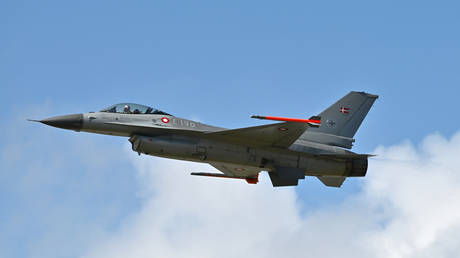 Western F-16s ‘can’t compete’ with Russian Su-35s – Ukrainian Air Force
Western F-16s ‘can’t compete’ with Russian Su-35s – Ukrainian Air Force
The agency added that the proposed sale “will support the foreign policy goals… of the United States by improving the security of a partner country that is a force for political stability” in Europe.
More than 80 F-16s have been promised to Ukraine, with the bulk expected to come from Belgium and the Netherlands, while the US has never committed to providing the jets on its own. While the exact number of jets delivered is unknown, Moscow confirmed last month it had shot down one F-16. Ukraine’s Vladimir Zelensky said the aircraft’s pilot perished during a “combat mission.”
In 2024, Ukraine reported the loss of another F-16, saying it crashed while repelling a Russian air strike.
The DSCA announcement comes after the Pentagon said it is sending “disused and completely non-operational F-16s to Ukraine for parts.” It also follows the signing of a US-Ukraine resource deal that is intended to allow Washington to recover the cost of future military support through shared proceeds from Ukrainian mineral resource licenses.
Moscow has condemned the Western arms shipments to Ukraine, warning they will only prolong the conflict without changing the outcome. Russian President Vladimir Putin has said Ukrainian-operated F-16s will “burn” just like other Western-supplied equipment.
-
Site: Catholic Herald
One of the stories surrounding the conclave to elect Pope Francis’s successor – set to open on May 7 – is the unfamiliarity of the cardinal electors with one another. They are not all perfect strangers to one another but many of them don’t really know each other that well.
A record number of cardinals are eligible to vote for the next pope – 135 are under 80, although at least two will not be attending.
Francis appointed most of them. Many of them are from countries that never had a cardinal before, and their guys aren’t often in Rome meeting the other members of this very exclusive club.
But I wonder: Do they know each other on Facebook or Instagram?
This came to mind when I saw a post on X (formally Twitter).
It played an interview with Mark Zuckerberg – the founder of Facebook – on the advancement of Artificial Intelligence on social media, and how people are using AI to form “personal relationships” with artificial people.
“I think as the personalisation loop kicks in, and the AI just starts to get to know you better and better, I think that will just be really compelling,” Zuckerberg says.
Zuckerberg cites a statistic according to which the average American has fewer than three friends.
“[T]he average person has demand for something meaningfully more,” Zuckerberg says, “I guess it is like 15 friends or something.” He speculates that people are just too busy for more than three.
“But the average person wants more connectivity connection than they have,” he says in explanation of the reason for which “virtual friends” are becoming more popular.
This was an issue well before the explosion of AI in the past two years. Many people have hundreds of Facebook “friends”, many of them real people but who they have never really met.
They have “friendships” with these people, but both of them get to present a highly curated digital version of themselves – an artificial version, in a word — usually much better than their real, natural, actual realities (and occasionally much worse).
I was in my early 30s when Facebook came out and am in my 50s now. I have been able to reacquaint myself with many old friends from high school and university (and am so glad about this), but there are a number of people I don’t actually know, who are on my Facebook “friends” list. (I admit, I prefer the term “following” on Instagram and X.)
There have been various scandals on social media, where people are attacked for saying things seen as offensive, then defending themselves by declaring, “It was just a joke!” They may have a point: Often a person can make a joke to close friends that would seem very offensive to someone who didn’t know them and weren’t able to see the context of what they said.
But on social media, a thousand people might “like” the statement: some because they are the author’s actual friends, others because they do get the context and joke, and quite a few because they are, well, sociopaths. The thousands who are offended, are offended because out of context, the statement was offensive.
The algorithms that determine the content users see on social media platforms – the algorithms now apparently being somehow incorporated into these emerging AI “persons” – track individuals’ posts and “engagement” with others’ posts, and then show users content that the algorithms “think” the users want to see, or else they show them things that the algorithms calculate will make users angry – there is some overlap in the categories – basically, anything the algorithm determines likely to garner a click.
This puts people into echo chambers and is creating a new tribal culture that we as a society haven’t learned to deal with.
Yet Zuckerberg is not pointing out the dangers caused by “artificial” friends. He is suggesting they have an important role to play.
“I think that a lot of these things that today there might be a little bit of a stigma around, I would guess that over time, we will find the vocabulary as a society to be able to articulate why that is valuable and why the people who are doing these things… like why they are rational for doing it, and why it is valuable for their lives, but also I think the field is very early,” he says.
Reading the news, the questions facing the Church as we enter the conclave are centered on conservatives focused on “traditional values” and Latin Masses, and on progressives pushing for gay marriage and women clergy. These are the debates of the second half of the 20th century. The first part of the 21st century sees a society questioning what it means to be human, with “post humanism” being pushed by the leaders of many technology firms.
“I mean there are a handful of companies that are doing virtual therapists and there are virtual girlfriends and stuff, but it is very early,” Zuckerberg points out in his interview.
Call me a hopeless naif, but I think the cardinals would do well as they enter the conclave next week to remember the words of Jesus Christ in the Gospel according to John:
“This is my commandment: Love one another, as I have loved you. No one can have greater love than to lay down his life for his friends. You are my friends, if you do what I command you. I shall no longer call you servants, because a servant does not know the master’s business; I call you friends, because I have made known to you everything I have learnt from my Father.”
Jesus didn’t say that for the sort of recognition of being “Liked” on social media and building up his friendship base.
RELATED: Cardinal Müller says next pope must be ‘strong on doctrine’ and stand up to ‘gay lobby’
Photo: Cardinals depart a College of Cardinals meeting with other cardinals, during which the May 7 conclave date to elect Pope Francis’ successor was determined, Rome, Italy, 28 April 2025. (Photo by Mario Tama/Getty Images.)

The post Debating 20th-century problems in a 21st-century world: the conclave needs to catch up first appeared on Catholic Herald.
The post Debating 20th-century problems in a 21st-century world: the conclave needs to catch up appeared first on Catholic Herald.
-
Site: RT - News
Aleksandar Vucic reportedly had to end his visit to the US due to health issues
Serbian President Aleksandar Vucic abruptly ended a visit to the US on Friday after falling ill, Serbia’s state broadcaster RTS has reported.
Vucic had arrived in Florida on Wednesday for a series of meetings with US political figures and members of the Serbian diaspora. According to RTS, he began feeling unwell on Friday afternoon and sought medical attention. After consulting with doctors, he decided to return to Belgrade. No details about his condition have been released, and his office has not commented on the status of his remaining engagements.
During the trip, Vucic met with Congresswoman Claudia Tenney, former New York Mayor Rudy Giuliani, and former Illinois Governor Rod Blagojevich. He had also planned to meet with President Donald Trump and other senior Republican officials, though it is unclear whether the meeting with Trump took place.
Richard Grenell, Trump’s envoy for special missions and an envoy for Serbia-Kosovo negotiations during the president’s first term, wished Vucic a speedy recovery in a message posted on social media.
Read more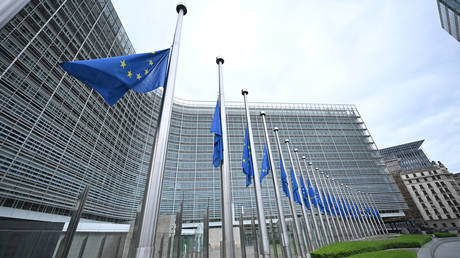 EU admits blackmailing Serbian leader over Moscow visit
EU admits blackmailing Serbian leader over Moscow visit
“Sending our best, @avucic. Sorry to miss you but hope all is ok,” he wrote on X.
In March, Vucic said he planned to travel to Moscow for Victory Day celebrations following his US visit. Russia is set to hold a traditional military parade on May 9 marking the 80th anniversary of the Soviet Union’s World War II victory over Nazi Germany.
Vucic’s plans has drawn criticism from the European Union. EU Enlargement Commissioner Marta Kos warned last week that his presence in Moscow could impact Serbia’s EU membership bid. Vucic, however, said he would not cancel the trip, noting that a Serbian military unit would participate in the parade.
-
Site: Real Investment Advice
Inside This Week's Bull Bear Report
- Economic Decline Gains Momentum
- How We Are Trading It
- Research Report - Investing Awards You Never Receive
- YouTube - Before The Bell
- Market Statistics
- Stock Screens
- Portfolio Trades This Week
Market Runs Into Resistance
Last week, we discussed that the market backdrop improved markedly following commentary from the White House that eased concerns about tariffs. To wit:
"The market rallied above the 20-DMA this past week as investors found some "silver linings" to the ongoing tariff dispute. Despite China saying "no negotiations" had started with the U.S., comments from both President Trump and Scott Bessent suggested that the Administration would "be nice" to China and that a "very good deal" could be done between the two countries. As we have noted previously, given the more extreme oversold condition of the market, any "good news" would allow investors to push stocks higher."
This past week, two reports confirmed the economy is slowing. First, there was the weak GDP report, which showed growth of roughly one percent, after discounting the impact of the trade deficit. Secondly, while the employment number was higher than expected, the job growth trend is also slowing. However, those reports should have tempered market enthusiasm as they reduced hopes for Fed rate cuts. However, the market pushed higher as investors raced to jump back into "risk assets" as the market cleared initial resistance at the 20-DMA and reversed all of the "Liberation Day" losses.
As we noted in "Hope In The Fear," it would take much for the market to mount a sizeable rally given the extremely negative sentiment and positioning. Last week, the potential break in the China stalemate and non-recessionary data fed the "short-covering" rally, and pushed the index above the 50-DMA. That rally has also reversed the more extreme bearish sentiment and pushed the number of stocks on "bullish buy signals" back to 70%.

Notably, the rally from the recent lows, which has seen the market rise for 9 consecutive days, is one of the longest win streaks in 20 years.

What should be notable about that statement is that all "win streaks" end, eventually. That statement does not mean the markets will crash, but given that the rally has pushed markets back into short-term overbought conditions. Furthermore, the 200- and 100-DMA will provide notable resistance to the continuation of this rally without a pullback first. As we noted previously, many "trapped longs" will look to exit the market as we approach full recovery from the "tariff breakdown."
Two Reasons To Be More Bullish
While bullish that the market has recovered 61.8% of its recent correction, a pullback should be expected. If you haven't rebalanced allocations and reduced risk somewhat, now is the time. However, look for retracements to the 50-DMA, then the recent support, and finally the 20-DMA as areas to rebuild equity exposure. Lastly, move stop losses in portfolios up to the 20-DMA for trading positions.

There are two reasons to be more constructive about the market over the coming month. First, May tends to be a better-performing month following Presidential elections, while June tends to be weak (hence the Wall Street axiom "Sell In May.")

Secondly, after a sharp reversal in April, which fueled the market selloff, share repurchases return next week as the bulk of the S&P 500 has announced earnings.

Optimism is returning to the market with economic data mainly remaining stable, earnings season coming in "better-than-expected," and the near-term tariff threat residing. However, as noted, we suggest being somewhat cautious following the recent sharp advance and using short-term pullbacks to recent support to reduce hedges and increase equity risk as needed.
As we advance into 2025, we expect volatility to remain a constant companion. This will be a function of both the realization that economic growth is slowing and the repricing of valuations as earnings estimates are revised lower to meet reality.
Need Help With Your Investing Strategy?
Are you looking for complete financial, insurance, and estate planning? Need a risk-managed portfolio management strategy to grow and protect your savings? Whatever your needs are, we are here to help.

Economic Decline Is Gaining Momentum
Given the recent strength in the economic data, we are not in the "recession" camp. However, there is little argument that an economic decline is gaining momentum. However, that decline should not be surprising since we repeatedly discussed it last year. To wit:
"One of the primary reasons why the economy has defied the recessionary drag from higher borrowing costs has been the ample supply of fiscal support through previously passed spending bills such as the Inflation Reduction Act and the CHIPs Act. When combined with stimulus checks, tax credits, and moratoriums on various debt payments like rent and student loans, the amount of monetary support for consumption supported economic growth as the Federal Reserve tightened monetary policy."

What is crucial to understand is that the surge in monetary support acted as an “adrenaline” boost to the economy. Yes, many economic data series suggest the risk of recession is elevated. However, the surge of monetary injections sent the economy into overdrive, as evidenced by economic growth in 2021. You can see this clearly in the chart below, which shows the annual rate of change in federal spending versus economic growth. As federal spending has slowed, so has the economy's annual growth rate.

As we noted last year, the crucial point that continues to elude most economists is that the economic decline will gain traction as that “adrenaline” boost fades. Had the economy been growing at 5% nominal, as in 2019, the decline from the post-pandemic peak would already register a recession. However, given that nominal growth neared 18%, it has taken far longer than many expected for economic decline to return to previous norms of just 2% annual growth.

In that previous article, we explained how the economic decline would take time to return to norms. To show this, we looked at the number of quarters between peak economic activity and the entrance into a recession. Using that historical analysis, we estimated that reversing economic growth into a recession could take roughly 22 quarters. Such would target the next downturn in late 2025 to mid-2026.

As we concluded then, many things could certainly happen to lengthen or shorten that estimated time frame. However, the importance is that an economic decline from elevated economic growth rates can take much longer than usual. Another similar period was the 25 quarters of slowing economic growth before the 1991 recession.
However, that analysis was "so last year." Things have certainly changed, particularly given the current Administration's tariffs and the potential impact on economic growth that those could foster. We have already seen a fairly sharp downturn in key economic indicators, showing that the economic decline is accelerating. That data appeared this past week in the Q1-GDP report, which showed a negative print for Q1 caused entirely by the front-running of tariffs, which created a record trade deficit. The BEA noted this following the release of the data.
"The decrease in real GDP in the first quarter primarily reflected an increase in imports, which are a subtraction in the calculation of GDP, and a decrease in government spending. These movements were partly offset by increases in investment, consumer spending, and exports."

Simultaneously, despite concerns about tariffs, the "stagflation" concerns were crushed by a drop in the Personal Consumption Expenditure (PCE) price index, which fell to just 2.3% annually.

So, the key question for investors is, where are we headed next? Economic slowdown or recession?
Key Indicators We Are Watching
There is currently no evidence that the economy is slipping into a recession. However, if you want to know if an economic decline will evolve into a recession, there is one key factor to consider: consumer spending. Consumer spending comprises nearly 70% of the GDP calculation, and everything else, from business investment to imports and exports, is a function of the consumer's "demand." In other words, if the consumer is slowing down or contracting spending, businesses will not "invest" in expansion projects, increasing employment, or buying more products for resale. That relationship is shown in the chart below, which compares PCE to employment and private investment.

As such, watching the consumer is critical to estimating economic outcomes. As we discussed in "The Consumer Is Tapping Out,"
"While GDP surged following the economic shutdown due to the massive flood of stimulus that fueled a savings surge, consumption as a percent of the economy has remained flat since the turn of the century. The reason is that despite the surge in savings, the consumer was also faced with rising inflation, which left them struggling to make ends meet."

"This dilemma is better illustrated by the chart below. The blue line is the personal savings rate, and the red line shows the debt needed annually to bridge the gap between the inflation-adjusted cost of living and savings and incomes. As shown, at the turn of the century, the consumer could no longer fund their living standard through just income and savings. The fact that consumers were forced to take on increasing debt levels to maintain their living standards explains why consumption as a percent of GDP has remained stagnant over the same period."

At the heart of the problem is the collapse of household balance sheets in the lower-income and middle-income brackets. These groups have depleted the excess savings accumulated during the pandemic and are now facing increasing pressures to maintain their standard of living. Here are a few examples:
- The Philadelphia Federal Reserve reported that the share of active credit card accounts making only minimum payments surged to 10.75% in Q3 2024—a record high.
- Credit card delinquency rates have increased 33 basis points year-over-year to 3.52% in the third quarter of 2024. This represents more than double the delinquency rate of 1.57 percent at the pandemic low in the second quarter of 2021.
- According to the University of Michigan, consumer sentiment in the United States has fallen to the second-lowest reading ever recorded…
- A new CNBC/SurveyMonkey poll found that 73 percent of U.S. consumers are “financially stressed."
- 63% of people with savings accounts have withdrawn money since the beginning of 2025, primarily for unexpected expenses (48%) and everyday necessities (36%)
- 67% of Americans feel behind on their savings goals, with nearly half (47%) believing they’ll never reach their targets
Those issues feed into three key indicators we are watching very closely.
The first is our composite economic index, which comprises nearly 100 data points of both soft and hard economic variables. That indicator has a very high correlation to economic growth and has decreased sharply over the last two months, which confirms the Q1 weakness and could continue into Q2. Such sharp reversals regularly coincide with economic declines and recessions. However, the current reading remains above "recession" levels, below 30. This suggests slower economic growth but no recession yet.

Secondly, the 6-month rate of change in the leading economic indicators (LEI). As with the economic composite, the LEI index suggests the economy should be in a recession. In its entire history, the indicator has had a perfect record of recession prediction, except recently. Again, this was because of the massive flood of stimulus, but with that support gone, we should see weakness return to the LEI indicator, suggesting further economic decline. In other words, the recent improvement will likely fail as we saw heading into 2008.

Lastly, credit spreads remain key to navigating an economic decline or a recession. We have discussed credit spreads in the past, but for investors, they are critical to understanding market sentiment and predicting potential stock market downturns. A credit spread refers to the difference in yield between two bonds of similar maturity but different credit quality. This comparison often involves Treasury bonds (considered risk-free) and corporate bonds (which carry default risk). By observing these spreads, investors can gauge risk appetite in financial markets. Such helps investors identify stress points that often precede stock market corrections.
The spread below, risk-free versus the most risky (high-yield, or junk bonds), is the most important to watch.

In the linked article above, we noted that this spread has been a reliable predictor of market corrections and bear markets and coincides with economic declines and recessions. This makes sense given that the high-yield bond market consists of debt issued by companies with lower credit ratings. Such makes them more vulnerable to economic slowdowns. As such, when investors become concerned about economic prospects, they demand significantly higher returns to hold these riskier bonds. When that happens, the spreads widen warning of increasing risks.
Historically, sharp increases in the high-yield spread have preceded economic recessions and significant market downturns, giving it a high degree of predictive power. According to research by the Federal Reserve and other financial institutions, the high-yield spread has successfully anticipated every U.S. recession since the 1970s. Typically, a widening of this spread by more than 300 basis points (3%) from its recent low has been a strong signal of an impending market correction.
Currently, that particular yield spread remains well contained. Still, when it reverses, it tends to do so quickly. As such, yield spreads are a better "real-time" indicator than lagging economic data.
The latest economic data confirms what we already knew: economic growth is weakening faster than many expect. For investors, that economic decline threatens the one thing markets care about: earnings.
Watching For Earnings Impact
While the first quarter earnings season has been okay, earnings over the next few quarters will likely be revised lower. So far, earnings estimates for the S&P 500 index (by S&P Global) remain extremely optimistic. In the last two months, S&P Global has raised its estimates for 2026 GAAP earnings (reported) from $289/share to $292/share. As we have discussed previously, these estimates are exceedingly deviated from the long-term growth trend of earnings.

Such is particularly an issue for investors when economic data and inflation decline.
Historically, GDP growth has closely correlated with corporate earnings growth. Data from the Federal Reserve shows that, since 1948, a 1% increase in real GDP growth has translated to roughly a 6% increase in S&P 500 earnings on average. This relationship underscores why GDP is a cornerstone for assessing earnings trends. We can also see this visually.
“Since 1947, earnings per share have grown at 7.7% annually, while the economy expanded by 6.40% annually. That close relationship in growth rates should be logical, particularly given the significant role that consumer spending has in the GDP equation.” – Market Forecasts Are Very Bullish
A better way to visualize this data is to look at the correlation between the annual change in earnings growth and inflation-adjusted GDP. There are periods when earnings deviate from underlying economic activity. However, those periods are due to pre- or post-recession earnings fluctuations. Currently, economic and earnings growth are very close to the long-term correlation.

However, that assumes that GDP continues growing at roughly 2% annually. If economic growth deteriorates, as expected, then maintaining corporate earnings at projected levels becomes more difficult. Such is particularly the case when consumer confidence is contracting sharply, particularly in the outlook for higher incomes over the next 6 months.

With expectations for incomes to decline and earnings tied to personal consumption, the risk of an economic slowdown should eventually be reflected in negative revisions to earnings expectations. That reduction in estimates will ultimately be reflected in the market price. Such is why there is a correlation between PCE (consumer activity drives earnings) and the annual percentage change in the stock market.

The incoming economic data is weakening, and there is clear evidence that the consumer is slowing down. While this does not mean a "recession" is coming, an economic decline is probable. As such, investors need to adjust their expectations for slower economic growth, increased market volatility, and lower forward returns.
How We Are Trading It
If the economy is slowing down and valuations adjust for lower forward earnings expectations, the most significant risk for investors is navigating market volatility. That doesn't mean markets will crash. However, it does suggest that many investors will fall victim to emotional mistakes in a sideways market. The need for a more conservative approach is rising, with forward returns lower and more volatile than promised.
The formula for investment success is controlling risk, reducing emotional investment mistakes, and limiting the destruction of investment capital. Here are some guidelines:
- Focus on capital preservation
- Forget about "beating the market" and target a rate of return sufficient to keep pace with the rate of inflation.
- Keep expectations based on realistic objectives. (The market does not compound at 8%, 6% or 4%)
- Realize that chasing higher rates of return require an exponential increase in the underlying risk profile. Such tends to not work out well.
- Remember that while you can replace lost capital – but you can’t replace lost time. Time is a precious commodity that you cannot afford to waste.
- Your portfolio is time-frame specific. If you have a 5-years to retirement but build a portfolio with a 20-year time horizon (increasing draw-down risk,) the results will likely be disastrous.
We continue to manage our portfolios with an above-normal level of caution. This week, we added to our short-market hedge and slightly increased the duration of our bond portfolio as the "basis trade" crisis we discussed two weeks ago seems to be under control. However, that risk is not entirely over.
As noted above, there is an elevated level of risk ahead as we approach the 200-DMA. The large supply of stock for sale and potential for continued weak economic data are key factors. While we don't expect the market to crater to new lows unless there is another tariff or trade shock and a surge in recessionary data, a retest of recent lows would be unsurprising. As such, we are carrying an overweight position in cash and reduced equity allocations for now.
As an investment manager, we are neither bullish nor bearish. We view the markets through the lens of statistics and probabilities. Our job is to manage the inherent risk to investment capital for our clients. While it is true that markets have always recovered their losses, getting back to even isn’t the same thing as making money.
Have a great weekend.
(Note: The allocation below contains a 5% short S&P 500 position in the ETF allocation.)

Feel free to reach out if you want to navigate these uncertain waters with expert guidance. Our team specializes in helping clients make informed decisions in today’s volatile markets.
Research Report

Subscribe To “Before The Bell” For Daily Trading Updates
We have set up a separate channel JUST for our short daily market updates. Please subscribe to THIS CHANNEL to receive daily notifications before the market opens.
Click Here And Then Click The SUBSCRIBE Button
Subscribe To Our YouTube Channel To Get Notified Of All Our Videos
Bull Bear Report Market Statistics & Screens

SimpleVisor Top & Bottom Performers By Sector

S&P 500 Weekly Tear Sheet

Relative Performance Analysis
Two weeks ago, we stated, "While risk is subsiding in the near term, there is a lack of a catalyst to move stocks higher. Some good news on the tariff front or better-than-expected earnings over the next two weeks could provide relief. However, by the end of the month, stock buybacks return, which will give some support to equities headed into May."
That good news continued this past week, as "not-as-bad-as-expected" earnings announcements and a potential breakthrough with China kept the rally going. That support could continue into the end of the month, with the stock buyback window now open, adding a further buyer to the market. With sentiment still largely suppressed, and shorts needing to cover as markets rally, the pressure will remain to the upside. However, with markets short-term overbought, expect corrections to support, which can be used to add equity exposure as needed and reduce hedges.

Technical Composite
The technical overbought/sold gauge comprises several price indicators (R.S.I., Williams %R, etc.), measured using “weekly” closing price data. Readings above “80” are considered overbought, and below “20” are oversold. The market peaks when those readings are 80 or above, suggesting prudent profit-taking and risk management. The best buying opportunities exist when those readings are 20 or below.
The current reading is 49.99 out of a possible 100.

Portfolio Positioning “Fear / Greed” Gauge
The “Fear/Greed” gauge is how individual and professional investors are “positioning” themselves in the market based on their equity exposure. From a contrarian position, the higher the allocation to equities, the more likely the market is closer to a correction than not. The gauge uses weekly closing data.
NOTE: The Fear/Greed Index measures risk from 0 to 100. It is a rarity that it reaches levels above 90.
The current reading is 55.95 out of a possible 100.

Relative Sector Analysis

Most Oversold Sector Analysis

Sector Model Analysis & Risk Ranges
How To Read This Table
- The table compares the relative performance of each sector and market to the S&P 500 index.
- “MA XVER” (Moving Average Crossover) is determined by the short-term weekly moving average crossing positively or negatively with the long-term weekly moving average.
- The risk range is a function of the month-end closing price and the “beta” of the sector or market. (Ranges reset on the 1st of each month)
- The table shows the price deviation above and below the weekly moving averages.
As noted last week, the rally this past week was unsurprising given the large number of markets and sectors trading well below the monthly risk ranges. However, given that most markets and sectors are trading with "bearish" crossovers, the correction process has likely not ended, so remain cautious. Historically, when most markets and sectors are trading bearish, the correction process is more entrenched and lasts longer than normal market pullbacks.

Weekly SimpleVisor Stock Screens
We provide three stock screens each week from SimpleVisor.
This week, we are searching for the Top 20:
- Relative Strength Stocks
- Momentum Stocks
- Technical Strength W/ Dividends
(Click Images To Enlarge)
RSI Screen

Momentum Screen

Technically Strong With Dividends

SimpleVisor Portfolio Changes
We post all of our portfolio changes as they occur at SimpleVisor:
Apr 30th
Trade Alert – Equity & ETF Models
With the market’s roughly 50% retracement from the recent lows, we are adding to our short S&P 500 index ETF (SH) to increase our portfolio hedge. With big earnings out today after the bell and tomorrow, along with employment on Friday, there is plenty of news to bring sellers back into the market near-term. As such, we remain more cautious and willing to sacrifice some near-term performance to reduce downside risk. We will remove the shorts and increase equity allocations when the market becomes more constructive.
Equity Model
- Increase SH to 5% of the portfolio.
ETF Model
- Increase SH to 5% of the portfolio.
Lance Roberts, C.I.O., RIA Advisors
The post Economic Decline Gains Momentum appeared first on RIA.
-
Site: RT - News
An AI-generated image shows the US president in papal robes as the Vatican prepares to elect a new pope after Francis’ death
US President Donald Trump has posted an AI-generated image of himself in papal attire, just days after joking about becoming the next pope. The image, shared on his Truth Social platform on Saturday, depicts Trump in white papal robes, a gold crucifix, and a mitre, with his right hand raised in a traditional papal gesture.
The post follows comments Trump made earlier this week to reporters. “I’d like to be pope, that would be my number one choice,” he said in response to questions about potential successors to Pope Francis, who died on April 21. He went on to praise Cardinal Timothy Dolan of New York as “very good,” though Vatican observers note that the election of an American pope is unlikely.
The president and First Lady Melania Trump attended Pope Francis’ funeral in Rome on April 26, which marked his first international trip since returning to office in January.
The AI-generated image sparked mixed reactions online. Some users found it humorous, while others criticized it as inappropriate, accusing Trump of mocking the death of the late pope.
The Vatican has confirmed that the papal conclave to elect a new pope will begin on May 8, with cardinals from around the world convening in the Sistine Chapel to vote in secrecy.
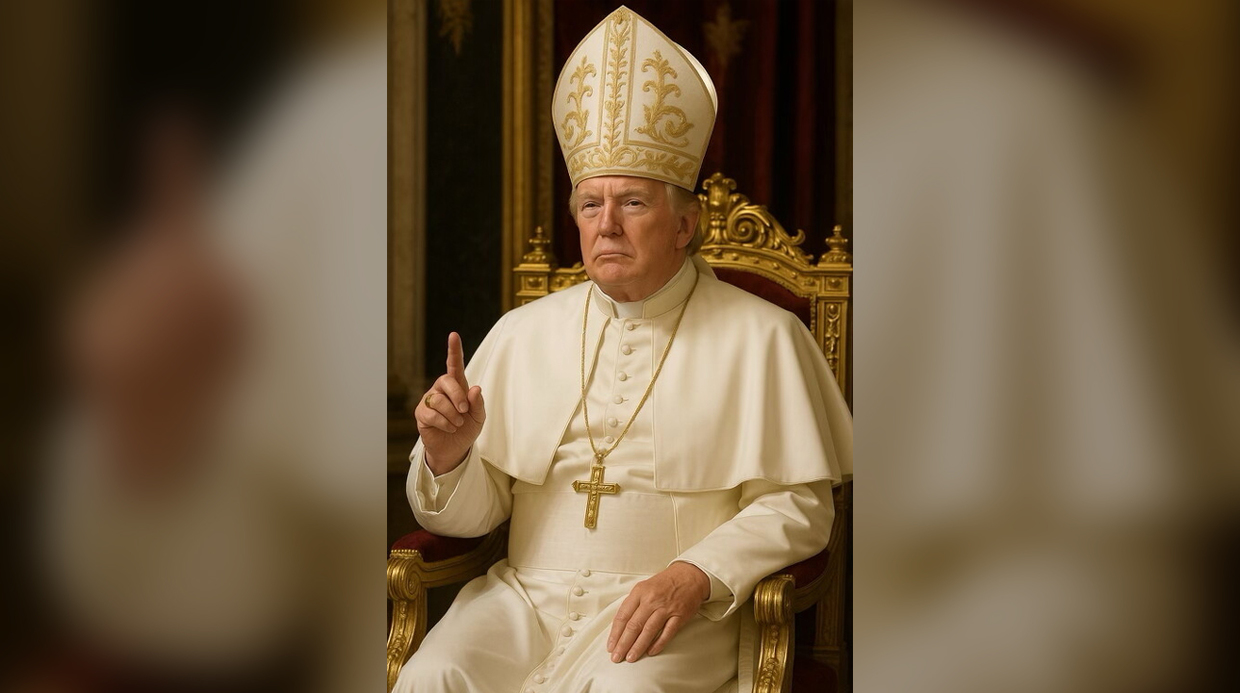 © Truth Social / @realDonaldTrump
© Truth Social / @realDonaldTrump
Trump and Pope Francis have a history of verbal clashes, especially over immigration and social issues. During his second term, Trump introduced strict immigration policies, including mass deportations, which drew criticism from the Vatican.
In a letter to US Catholic bishops this year, Pope Francis called the crackdown a “major crisis” that harms the dignity of migrants, and warned against portraying undocumented people as criminals.
Their tensions go back to 2016, when Pope Francis said anyone who builds walls instead of bridges is “not Christian” – widely seen as a swipe at Trump’s border wall. Trump called the remark “disgraceful” and accused the Mexican government of using the Argentine-born pope as a “pawn.”
-
Site: Catholic Herald
Each day between now and the May 7 conclave to elect a successor to Pope Francis, we are running a profile of a different “papabile”, the Italian term for a man who could be pope. There’s no precise way to identity these contenders; it’s mostly a matter of weighing reputations, positions held and influence wielded over the years. There’s also certainly no guarantee one of these candidates will emerge wearing white; as an old bit of Roman wisdom has it, “He who enters a conclave as a pope exits as a cardinal.” But these profiles will feature the leading names drawing buzz in Rome right now, at least making it very likely that they will get a look. Knowing who these men are also suggests issues and qualities other cardinals see as desirable heading into the election.
In the classic 1941 film noir, a cultured criminal named Kasper Gutman says to the rough-around-the-edges detective Sam Spade, “By gad, sir, you are a character! There’s never any telling what you’ll say or do next, except that it’s bound to be something astonishing.”
That bit of dialogue, of course, comes from the John Huston classic Maltese Falcon, but it might well also be said of the great Maltese contender in the 2025 conclave, 68-year-old Cardinal Mario Grech.
During his run as the Bishop of Gozo in Malta from 2005 to 2019, Grech generally was considered a conservative, seen as standing to the right of, and sometimes at odds with, Archbishop Charles Scicluna, who heads the Archdiocese of Malta.
That reputation, however, dissolved like sugar in hot coffee once Grech was appointed Secretary General of the Synod of Bishops by Pope Francis, a role in which he became a champion of the late pontiff’s vision for a more “synodal” Church and of the progressive reform causes with which the synod came to be associated.
You thus never quite know what you might get from Grech, but it is often something astonishing.
Born in Gozo in 1957, the young Grech attended a grade school run by the Carmelite sisters and then entered the diocesan seminary of Gozo. He was ordained to the priesthood in 1984 and shipped off to Rome for further studies at the Pontifical Lateran University, where, among other things, he learned Italian. He later earned a doctoral degree in canon law from the University of St. Thomas, the “Angelicum”, and worked for the Roman Rota, the Vatican’s main working court, which mostly handles marriage cases.
After a period back in Malta as a priest, much of its spent working on church tribunals, Grech was named the Bishop of Gozo by Pope Benedict XVI in November 2005. He launched an ambitious diocesan mission, including visiting Maltese diaspora communities in various parts of the world; created a number of commissions and other initiatives, including a diocesan commission for the protection of children and vulnerable adults from sexual abuse; and served as the representative of the Maltese bishops both to the European bishops’ conference and the Italian bishops’ conference.
In April 2010, Grech hosted Pope Benedict during a brief two-day visit to Malta to mark the 1,950th anniversary of St. Paul’s famous shipwreck on the island.
When a debate broke out in 2011 over the legalisation of divorce in Malta, Grech came out in opposition in tandem with the island’s clergy, warning that voters would be “accountable to Jesus”. (A referendum allowing divorce passed with 53 percent of the vote.)
He also became an outspoken defender of migrants during Malta’s migrant and refugee crisis, accusing elements of Maltese society pushing for a policy of closure of “racism”. At one point, he criticised Italian politician Matteo Salvini, leader of the far-right Lega party, for brandishing a rosary while engaging in anti-immigrant tirades during campaign rallies.
When Pope Francis summoned his ambitious Synods of Bishops on the Family in 2014-15, Grech surprised many observers by his welcoming and positive language on LGBTQ+ Catholics, in a talk which attracted favorable attention from the pontiff. There were rumors at the time that he might be named the Archbishop of Malta, but local Maltese media suggested a letter from some of his priests in Gozo complaining of an excessive attachment to material goods and poor government, including in regard to an abuse case, scuttled his chances.
In 2017, Grech and Scicluna issued guidelines for Malta on the implementation of Francis’s post-synodal document Amoris Laetitia, which in a footnote opened a cautious door for the reception of communion by Catholics who divorce and remarry outside the Church. At the time, some saw the Maltese guidelines as going even farther than the Pope, although they were eventually published in L’Osservatore Romano, the Vatican newspaper, suggesting a sort of official endorsement.
By the time Grech was tapped to run the Synod of Bishops in 2019, he was considered a solidly pro-Francis figure in the global hierarchy. His administration of the two Synods on Synodality certainly burnished that reputation, giving him multiple occasions to extol the ideals of a more listening, participatory and inclusive Church.
In 2022 he also rejected an open letter from a group of more conservative Catholic bishops criticising the progressive German “synodal way”, calling the statement “polarising” and voicing confidence the Germans knew what they were doing.
What’s the case for Grech as pope?
To begin with, in a conclave in which so many cardinals are strangers to one another, he’s a known quantity. Of the 133 cardinals set to file into the Sistine Chapel next Wednesday, 62 of them took part in at least one of the two synods on synodality, meaning they’re used to seeing Grech sit in the front of the room and in charge. That in itself might be a selling point in a moment in which cardinals, feeling out of their depth, may be looking for someone to follow.
In addition, Grech would be seen as a vote for continuity with the Pope Francis agenda, but perhaps with slightly more legal precision and grounding given his deep background in Church law. In other words, pro-Francis voters might see him as someone who could institutionalise the late pope’s legacy.
The case against?
First of all, the fact that he has changed so his tune so dramatically from the Benedict years in Gozo to the Francis years in Rome may be seen by some voters as evidence of an unreliable shifting with the wind, though others style it as an admirable capacity to change and grow with experience and circumstances. Certainly, cardinals looking for assurances of greater doctrinal clarity probably would look askance.
Moreover, a vote for Grech is likely a vote for continuing a three-year synodal process that Pope Francis issued while he was in Rome’s Gemelli Hospital battling double pneumonia, which is designed to culminate in a grand “ecclesial assembly” with roughly equal numbers of bishops, priests and deacons, religious and lay people. Some conservative critics see the process as undermining the hierarchical nature of the Church, but more broadly there’s simply a degree of “synod fatigue” among many prelates who may not be anxious to confirm yet another series of meetings on a theme many of them found amorphous and confusing.
Given there’s a general consensus that the next pope has to be a competent governor, among other things capable of tackling both the financial and the sexual abuse scandals that still haunt Catholicism, the concerns about Grech’s government style from his Gozo years probably don’t help his candidacy either.
Still, Grech has proven surprising capable over the years of adaptation and delivering surprises. Starting next Wednesday, we’ll see if he has one more surprise to spring.
RELATED: Taking charge of 1.4 billion souls: the spectacle gripping the world
Photo: Cardinal Mario Grech takes part in a media interview in St Peter’s square in Vatican City, 15 March 2025. (Photo by Christopher Furlong/Getty Images.)

The post Papabile of the Day: Cardinal Mario Grech, the ‘Maltese Falcon’ full of surprises first appeared on Catholic Herald.
The post Papabile of the Day: Cardinal Mario Grech, the ‘Maltese Falcon’ full of surprises appeared first on Catholic Herald.
-
Site: Crisis Magazine

In the previous essay in this series, we honored Blessed Otto Neururer, the first priest to be executed by the Nazis. We also acknowledged those better-known victims of the Third Reich’s anti-Christian pogrom, St. Maximilian Kolbe and St. Teresa Benedicta of the Cross (Edith Stein). It is also fitting, however, that we should commemorate some other largely-unknown victims of Hitler’s National…
-
Site: Rorate CaeliFr. Claude BartheRes NovaeMay 3, 2025Even prior to the opening of the pre-conclave General Congregations, the Eternal City has entered into a state of effervescence. The question has arisen as to whether the 135 cardinal electors, nearly 80% of whom were appointed by Francis, will bring to the pontificate a man whose governance will be in the same vein, or, on the contrary, a cardinal with a willNew Catholichttp://www.blogger.com/profile/04118576661605931910noreply@blogger.com
-
Site: AsiaNews.itThe truce for the Great Victory is a game of roles, with Putin wanting to prolong negotiations and appear victorious. The fourth parade since the start of the invasion of Ukraine, on the solemn 80th anniversary of the end of the conflict against Nazi Germany.The 'Russian mindset' among the cardinals at the Conclave. The Orthodox Patriarch shows the 'Russian paradise' against the devastation of war.
-
Site: RT - News
The package is ready to go, but it is unclear whether Donald Trump will approve it, as ceasefire negotiations continue, the report says
The US has finalized a new set of economic sanctions targeting Russia as leverage to force Moscow to settle the Ukraine conflict, Reuters reported on Friday, citing several sources. It remains unclear, however, whether US President Donald Trump will approve the measures.
Earlier media reports suggested that Trump has not ruled out the sanctions if a ceasefire is not reached soon. On Monday, Moscow offered a 72-hour ceasefire from May 8 to 10, portraying the initiative as a chance to begin “direct negotiations with Kiev without preconditions.” Ukraine’s Vladimir Zelensky dismissed the overture as “manipulation,” insisting on a 30-day truce.
The targets of the new sanctions under discussion include state-owned Russian energy giant Gazprom and major entities involved in the natural resources and banking sectors, an administration official told the agency, without providing specifics.
Read more New sanctions on Russia would mean two more years of war – Rubio
New sanctions on Russia would mean two more years of war – Rubio
Russia has been under US sanctions over the Ukraine crisis since 2014, which were dramatically tightened after the conflict escalated in 2022. Russia has called the sanctions illegal.
The US National Security Council “is trying to coordinate some set of more punitive actions against Russia,” a Reuters source familiar with the issue stated, adding that “this will have to be signed off by Trump.” Another unnamed US official said, “It’s totally his call.”
As the Trump administration has been actively engaged in negotiations with Moscow and Kiev to end the Ukraine conflict, it reportedly floated a peace plan that includes US recognition of Russian sovereignty over Crimea, as well as freezing the conflict along the current front lines and acknowledging Moscow’s control over large parts of the four former Ukrainian regions which voted to join Russia.
The deal would also reportedly initiate a phased removal of sanctions imposed on Russia and prevent Ukraine from joining NATO.
Meanwhile, US Republican Senator Lindsey Graham has said at least 72 senators now support “bone-crushing” sanctions if Russia resists peace talks. The senator insisted that the goal of this group “is to help the president” gain leverage on Russia.
Last month, US Secretary of State Marco Rubio questioned the wisdom of placing new restrictions on Moscow, stating that the Trump administration is “hoping to see” whether diplomacy will work first. “The minute you start doing that kind of stuff, you’re walking away from it, you’ve now doomed yourself to another two years of war and we don’t want to see it happen,” he said.
-
Site: AsiaNews.itToday's news: since 2003, incursions by settlers at the Al-Aqsa Mosque in Jerusalem have increased by over 18,000 per cent; According to RSF, press freedom has never been so 'difficult', with China and North Korea occupying the lowest positions;At least six people have been killed and 55 injured in a stampede at a Hindu temple in Goa;An armed man has killed three people in southern Thailand, with suspicions falling on an Islamic separatist;Hong Kong police have arrested the father and ...
-
Site: Mises InstituteCinephiles are mourning the death of Val Kilmer, who is remembered for many movies, but we ought also to be remembered for his performance in the underrated anti-war classic, Real Genius.
-
Site: Catholic Herald
By way of inspiration this weekend, and to provide a reminder of and insight into the heart and mind of the man who just left us, here are highlights of the late Pontiff’s memorable sayings:
On priestly ministry
A good priest can be recognised by the way his people are anointed: this is a clear proof. When our people are anointed with the oil of gladness, it is obvious: for example, when they leave Mass looking as if they have heard good news. Our people like to hear the Gospel preached with “unction”, they like it when the Gospel we preach touches their daily lives, when it runs down like the oil of Aaron to the edges of reality, when it brings light to moments of extreme darkness, to the “outskirts” where people of faith are most exposed to the onslaught of those who want to tear down their faith. People thank us because they feel that we have prayed over the realities of their everyday lives, their troubles, their joys, their burdens and their hopes. And when they feel that the fragrance of the Anointed One, of Christ, has come to them through us, they feel encouraged to entrust to us everything they want to bring before the Lord: “Pray for me, Father, because I have this problem”, “Bless me Father”, “Pray for me” – these words are the sign that the anointing has flowed down to the edges of the robe, for it has turned into a prayer of supplication, the supplication of the People of God.
—Chrism Mass, 28 March 2013On the Sacred Liturgy
We owe to the Council – and to the liturgical movement that preceded it – the rediscovery of a theological understanding of the Liturgy and of its importance in the life of the Church. As the general principles spelled out in Sacrosanctum Concilium have been fundamental for the reform of the liturgy, they continue to be fundamental for the promotion of that full, conscious, active, and fruitful celebration (cf SC 11; 14), in the liturgy “the primary and indispensable source from which the faithful are to derive the true Christian spirit” (SC 14). With this letter I simply want to invite the whole Church to rediscover, to safeguard, and to live the truth and power of the Christian celebration. I want the beauty of the Christian celebration and its necessary consequences for the life of the Church not to be spoiled by a superficial and foreshortened understanding of its value or, worse yet, by its being exploited in service of some ideological vision, no matter what the hue. The priestly prayer of Jesus at the Last Supper that all may be one (Jn 17:21) judges every one of our divisions around the Bread broken, around the sacrament of mercy, the sign of unity, the bond of charity.
—Desiderio desideravi, 29 June 2022On literature
Often during periods of boredom on holiday, in the heat and quiet of some deserted neighbourhood, finding a good book to read can provide an oasis that keeps us from other choices that are less wholesome. Likewise, in moments of weariness, anger, disappointment or failure, when prayer itself does not help us find inner serenity, a good book can help us weather the storm until we find peace of mind. Time spent reading may well open up new interior spaces that help us to avoid becoming trapped by a few obsessive thoughts that can stand in the way of our personal growth. Indeed, before our present unremitting exposure to social media, mobile phones and other devices, reading was a common experience, and those who went through it know what I mean. It is not something completely outdated.
—On Literature in Formation, 17 July 2024On the reform of penal law
In the past, great damage was done by a failure to appreciate the close relationship existing in the Church between the exercise of charity and recourse – where circumstances and justice so require – to disciplinary sanctions. This manner of thinking – as we have learned from experience – risks leading to tolerating immoral conduct, for which mere exhortations or suggestions are insufficient remedies. This situation often brings with it the danger that over time such conduct may become entrenched, making correction more difficult and in many cases creating scandal and confusion among the faithful. For this reason, it becomes necessary for bishops and superiors to inflict penalties. Negligence on the part of a bishop in resorting to the penal system is a sign that he has failed to carry out his duties honestly and faithfully.
—Pascite gregem Dei, 23 May 2021On the Sacred Heart
Our relationship to the Person of Jesus Christ is one of friendship and adoration, drawn by the love represented under the image of his heart. We venerate that image, yet our worship is directed solely to the living Christ, in his divinity and his plenary humanity, so that we may be embraced by his human and divine love. Whatever the image employed, it is clear that the living heart of Christ is the object of our worship, for it is part of his holy risen body, which is inseparable from the Son of God who assumed that body forever. We worship it because it is “the heart of the Person of the Word, to whom it is inseparably united”.
—Dilexit nos, 24 October 2024On young people
You, dear young people, are not the future. We like to say, “You are the future.” No, you are the present. You are not the future of God, you young people are the now of God. He invites you and calls you in your communities and cities to go out and find your grandparents, your elders; to stand up and with them to speak out and realise the dream that the Lord has dreamed for you. Not tomorrow, now, for wherever your treasure is now, there will your heart also be (cf Mt 6:21). Whatever you fall in love with, it will win over not only your imagination, it will affect every thing. It will be what makes you get up in the morning, what keeps you going at times of fatigue, what will break open your hearts and fill you with wonder, joy and gratitude. Realise that you have a mission and fall in love; that will decide every thing (cf. Pedro Arrupe SJ, Nada es más práctico). We may possess everything, but, dear young friends, if we lack the passion of love, we will have nothing. The passion of love today! Let us allow the Lord to make us fall in love and let him take us into the future!
—World Youth Day, 27 January 2019RELATED: Taking charge of 1.4 billion souls: the spectacle gripping the world
Photo: Pope Francis waves to thousands of followers as he arrives at Manila Cathedral in Manila, Philippines, 16 January 2015. (Photo by Lisa Maree Williams/Getty Images.)
This article appears in the May 2025 edition of the Catholic Herald. To subscribe to our thought-provoking magazine and have independent, high-calibre and counter-cultural Catholic journalism delivered to your door anywhere in the world click HERE.

The post ‘When it runs down like the oil of Aaron to the edges of reality’: The wisdom of Pope Francis first appeared on Catholic Herald.
The post ‘When it runs down like the oil of Aaron to the edges of reality’: The wisdom of Pope Francis appeared first on Catholic Herald.
-
Site: Catholic Herald
The Catholic Herald, one of the world’s oldest Catholic publications, has launched a regulated crowdfunding campaign as it embarks on its next chapter in 2025.
It has been a trusted and faithful voice in journalism for generations since its foundation in London in 1888, and is now primed for growth in the modern media age. It has now opened investment to the public for the first time in its 137-year history.
Now with an office in New York City as well as in London, The Catholic Herald is expanding its global-content footprint, investing in digital platforms and launching new initiatives that bring its vast archives to life – from original documentaries and podcasts to educational and cultural projects.
The crowdfunding launch comes at a time of renewed energy in faith-based communities and a growing interest in values-driven media. Across the US and indeed the world, a rising “traditional economy” is fuelling interest in Catholic education, publishing and cultural ventures that are rooted in belief and purpose.
Supporters can now invest directly in this growth through a live campaign with Republic, the leading equity crowdfunding platform. Click on the relevant link below to be redirected to the investor page.
For US, UK, EU & Rest of World Investors: click HERE.

The post Primed for growth: The Catholic Herald’s global crowdfunding campaign first appeared on Catholic Herald.
The post Primed for growth: The Catholic Herald’s global crowdfunding campaign appeared first on Catholic Herald.
-
Site: Mises InstituteMark Thornton cuts through the noise to explore the real economic threats facing America.

